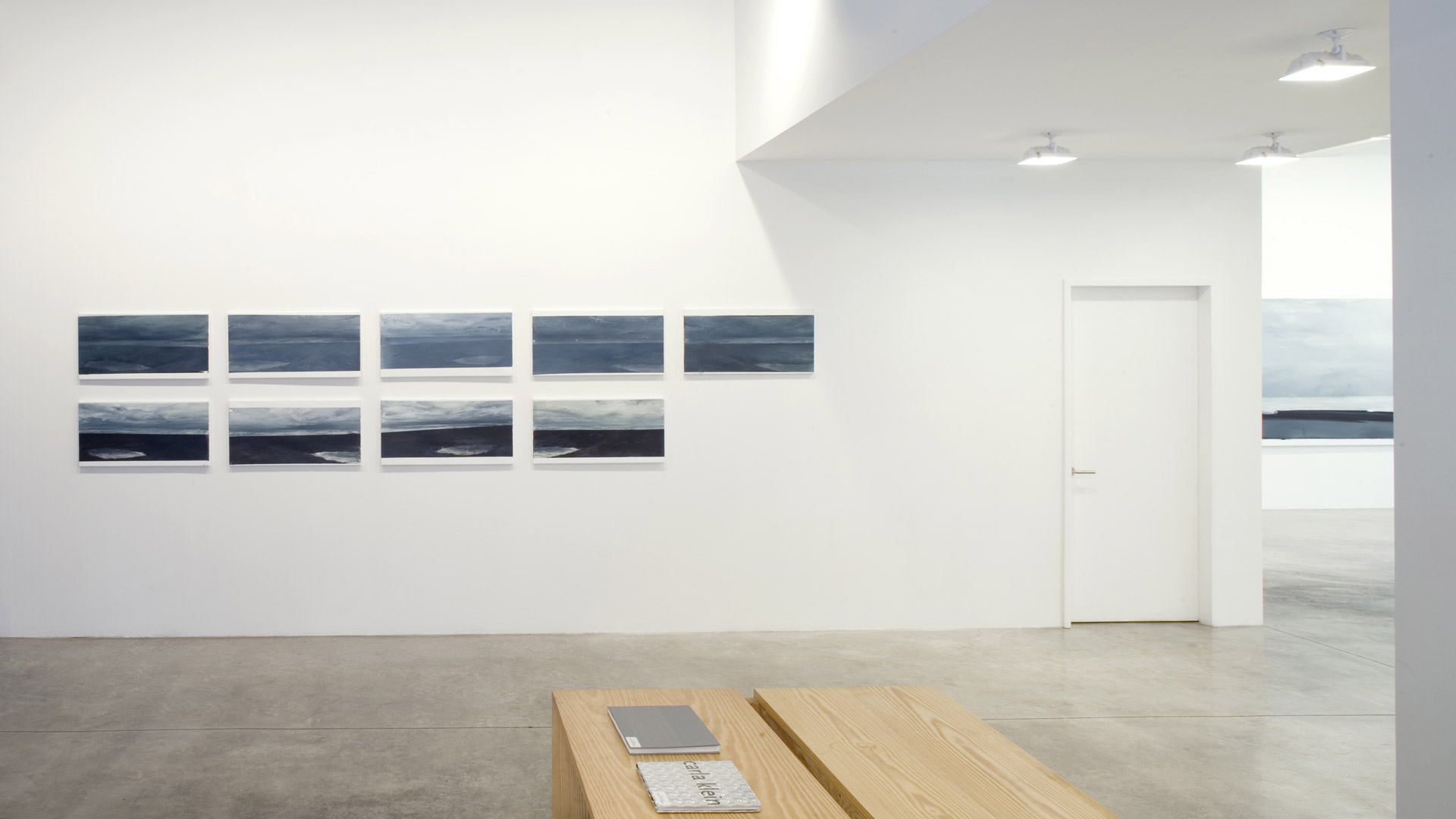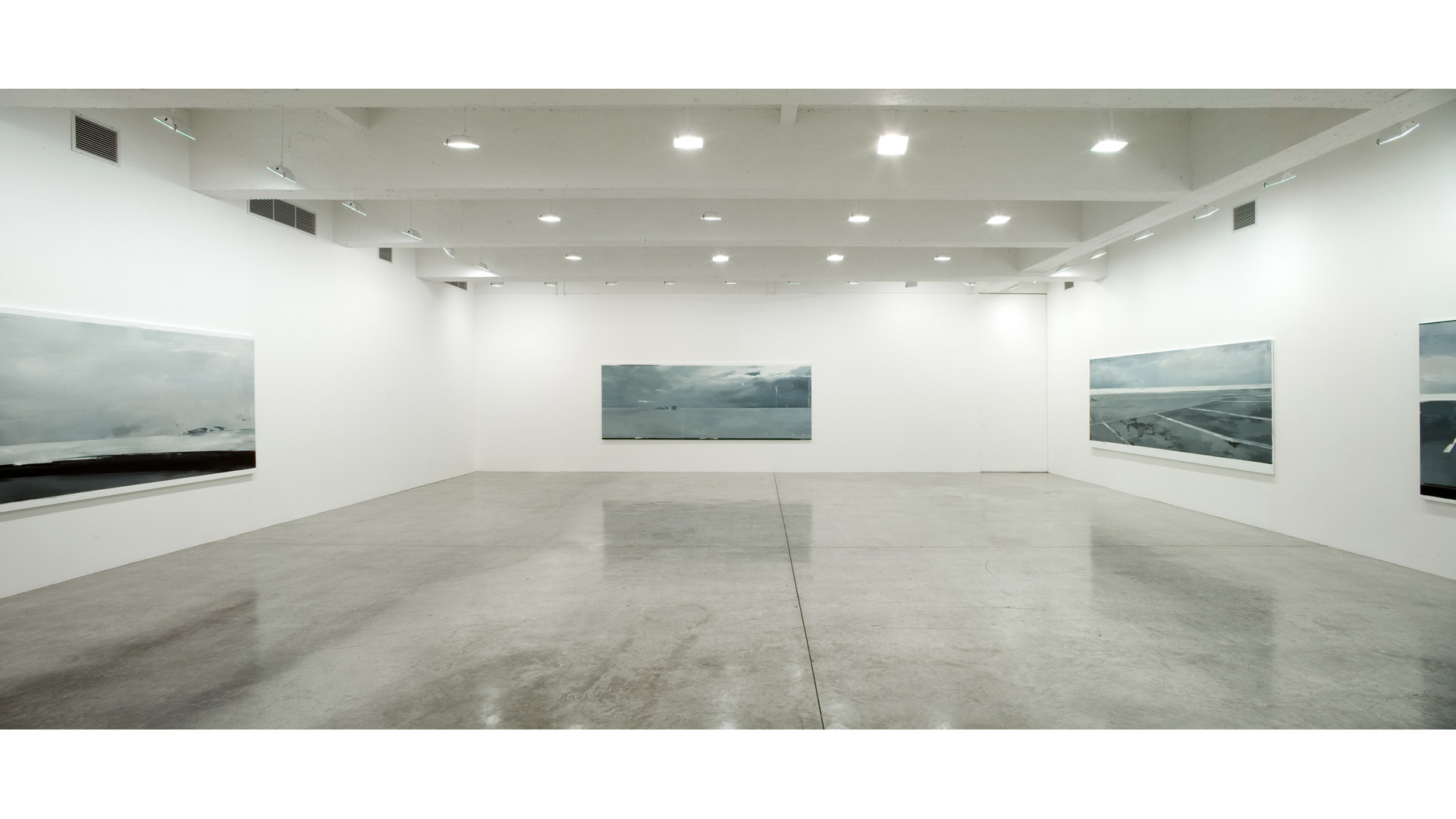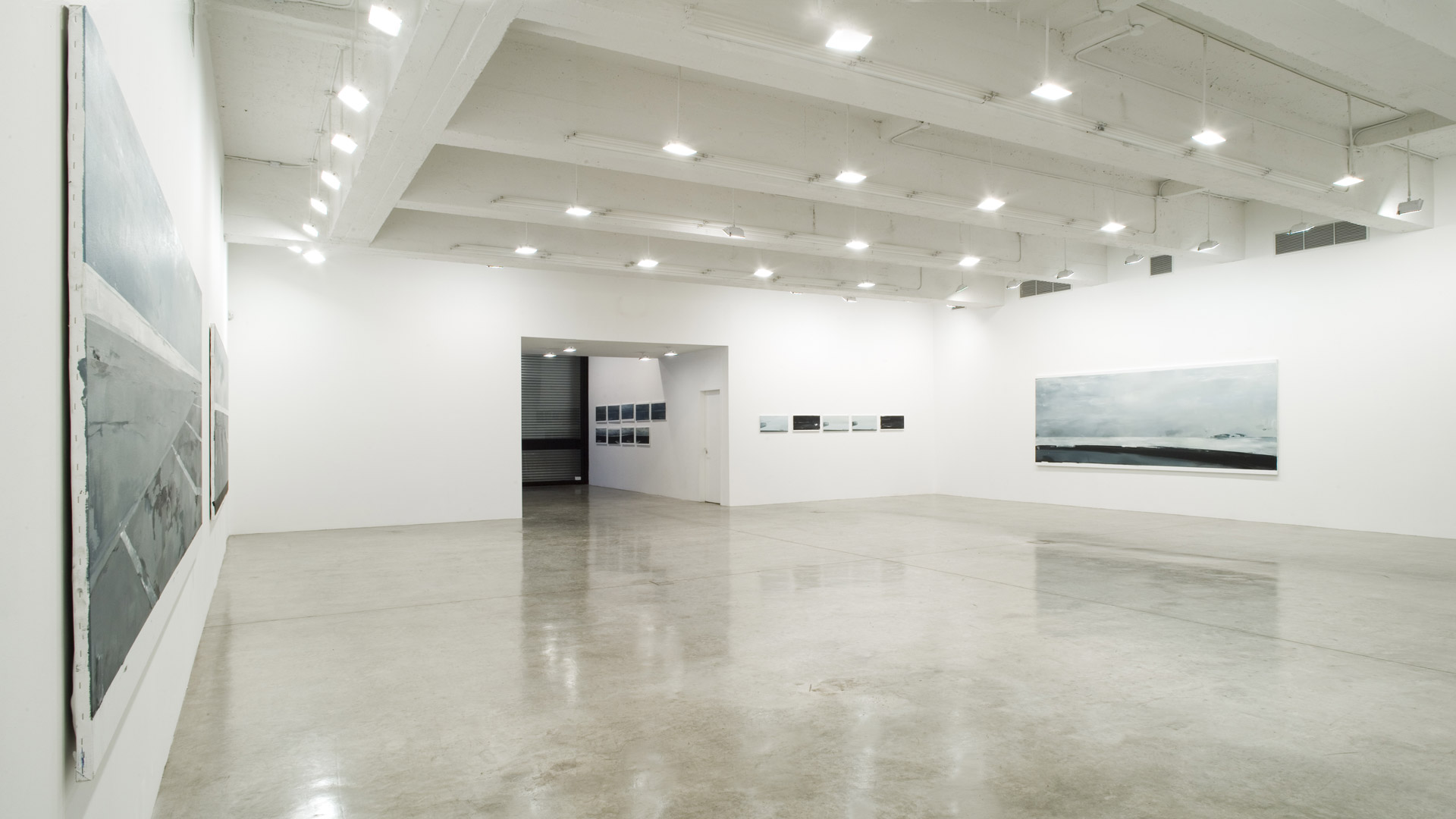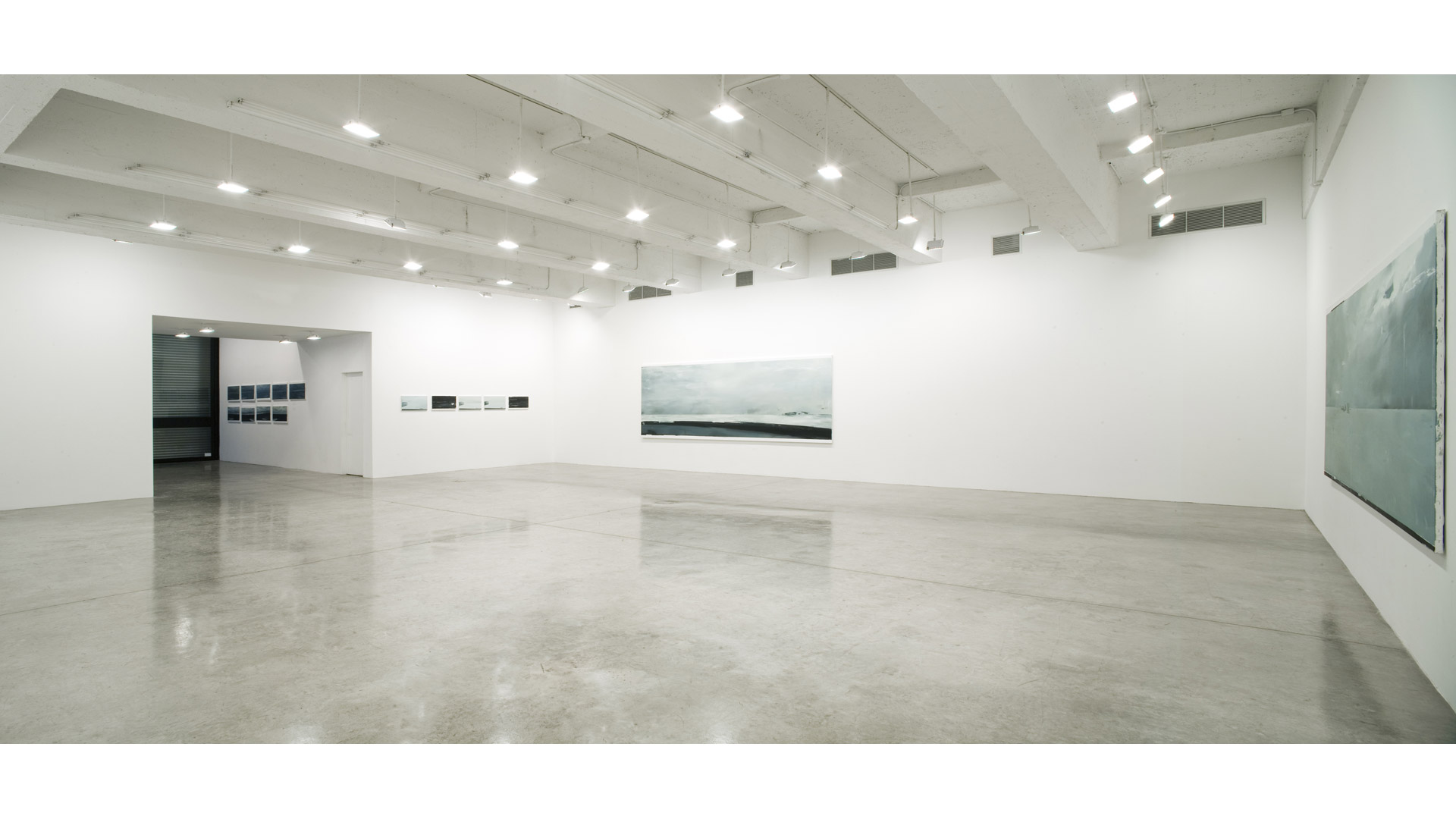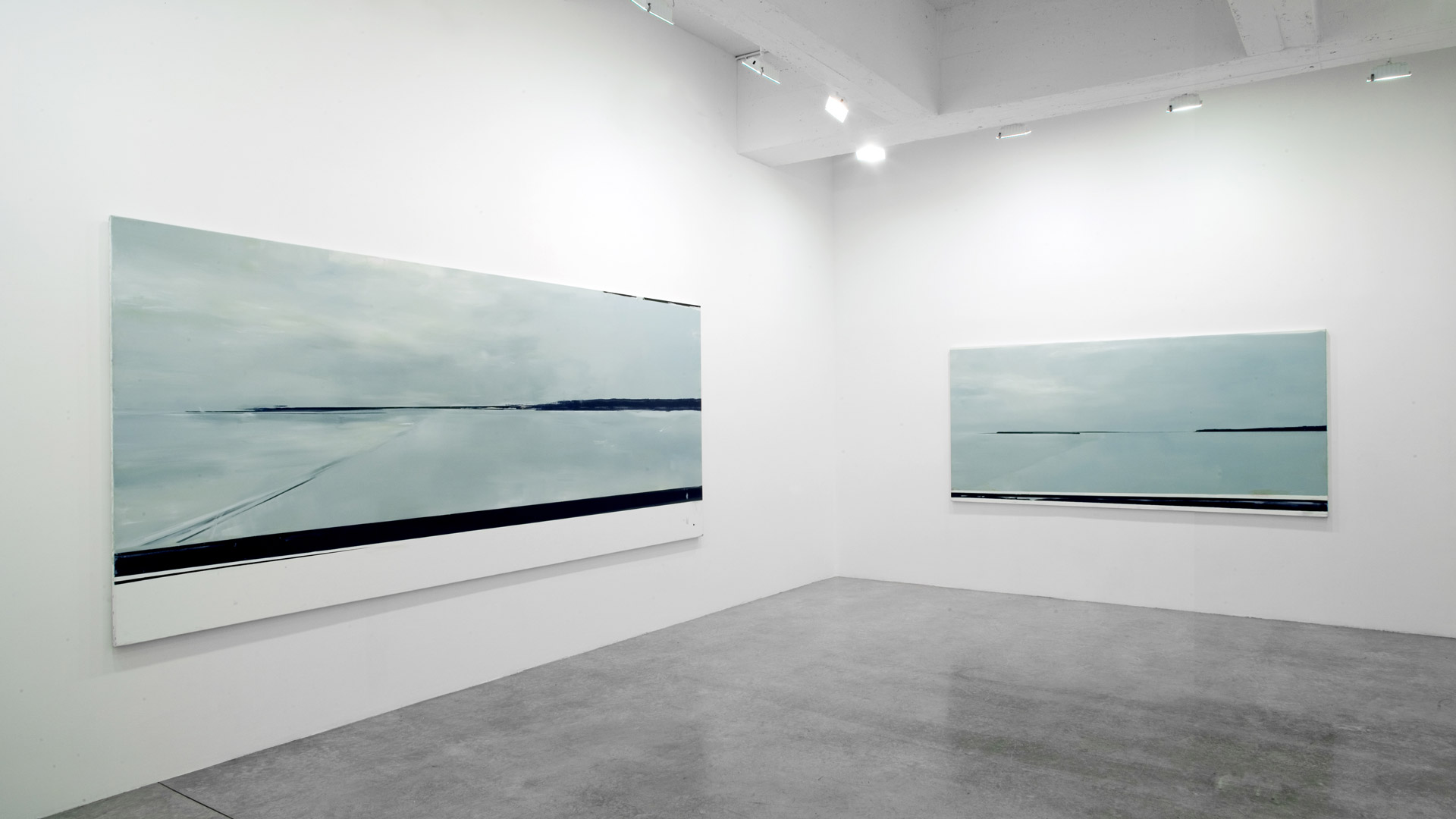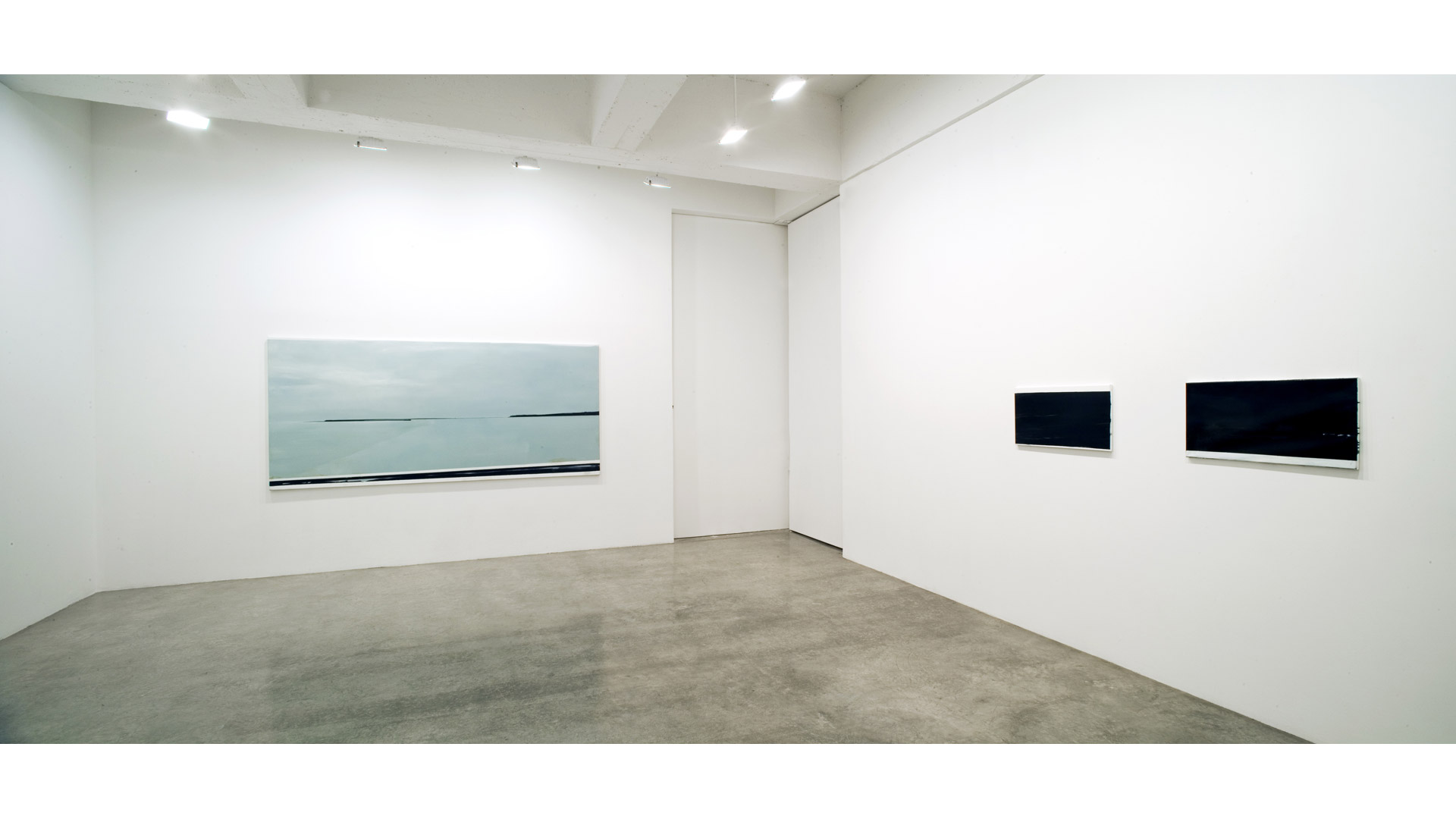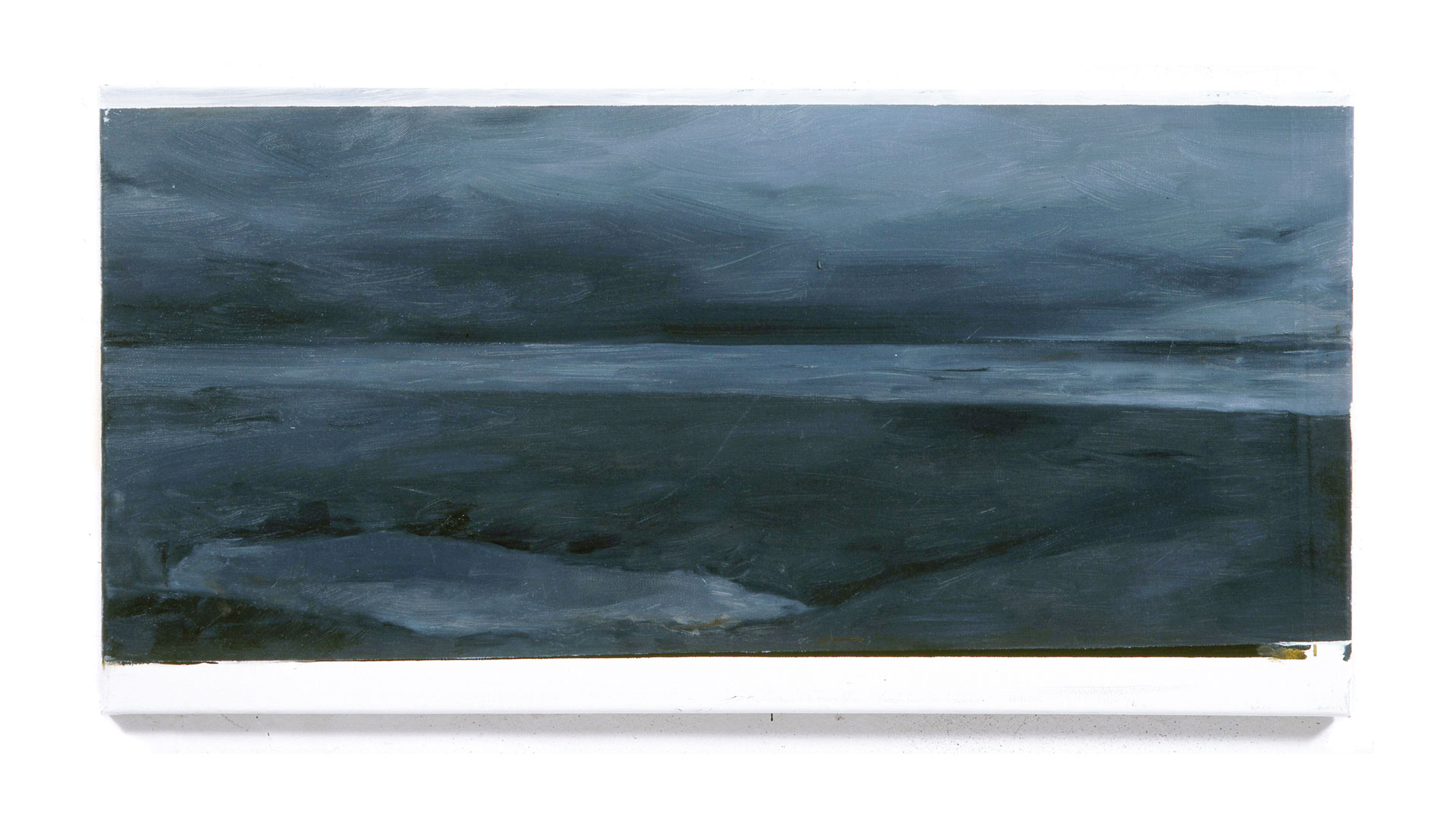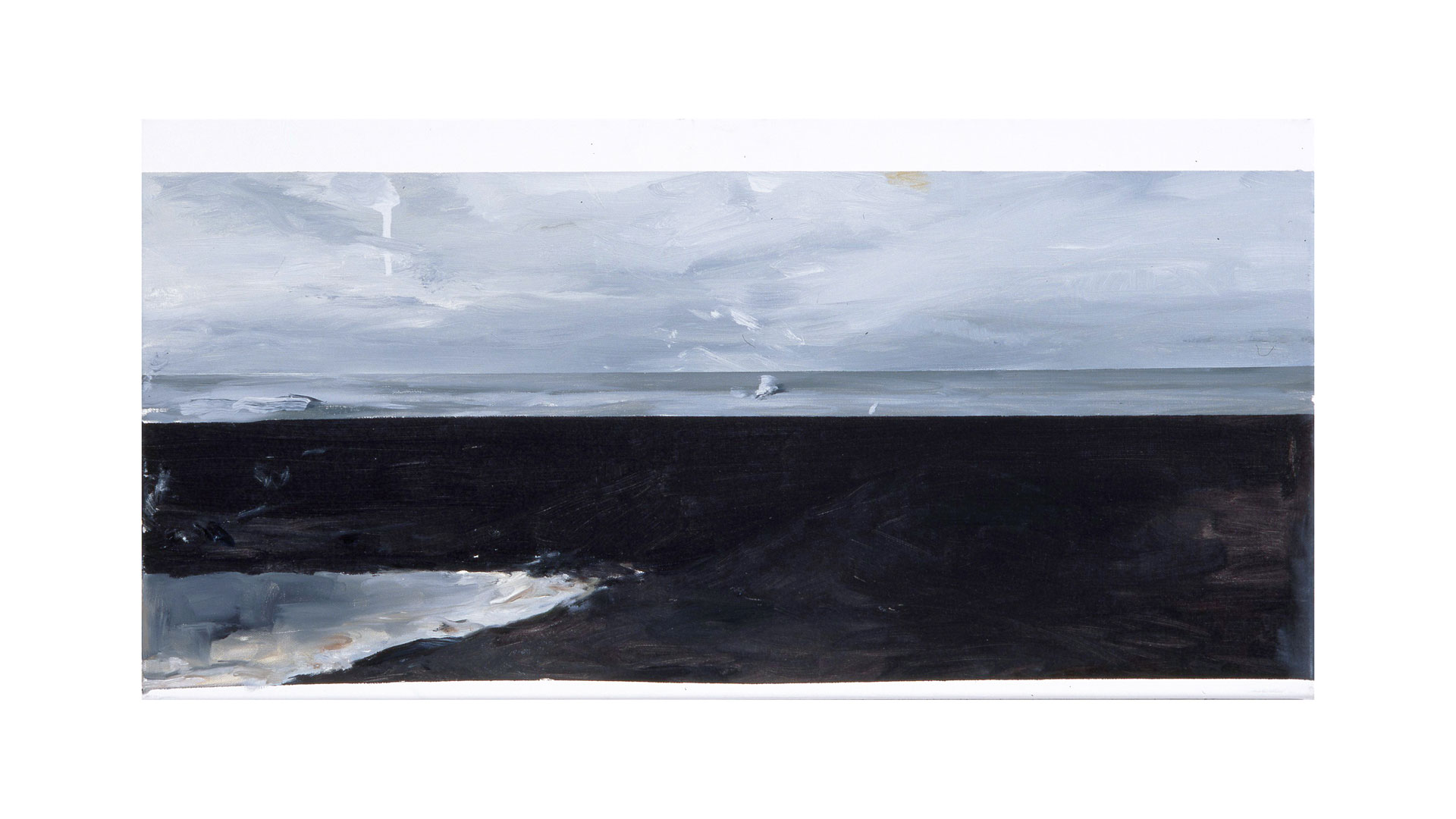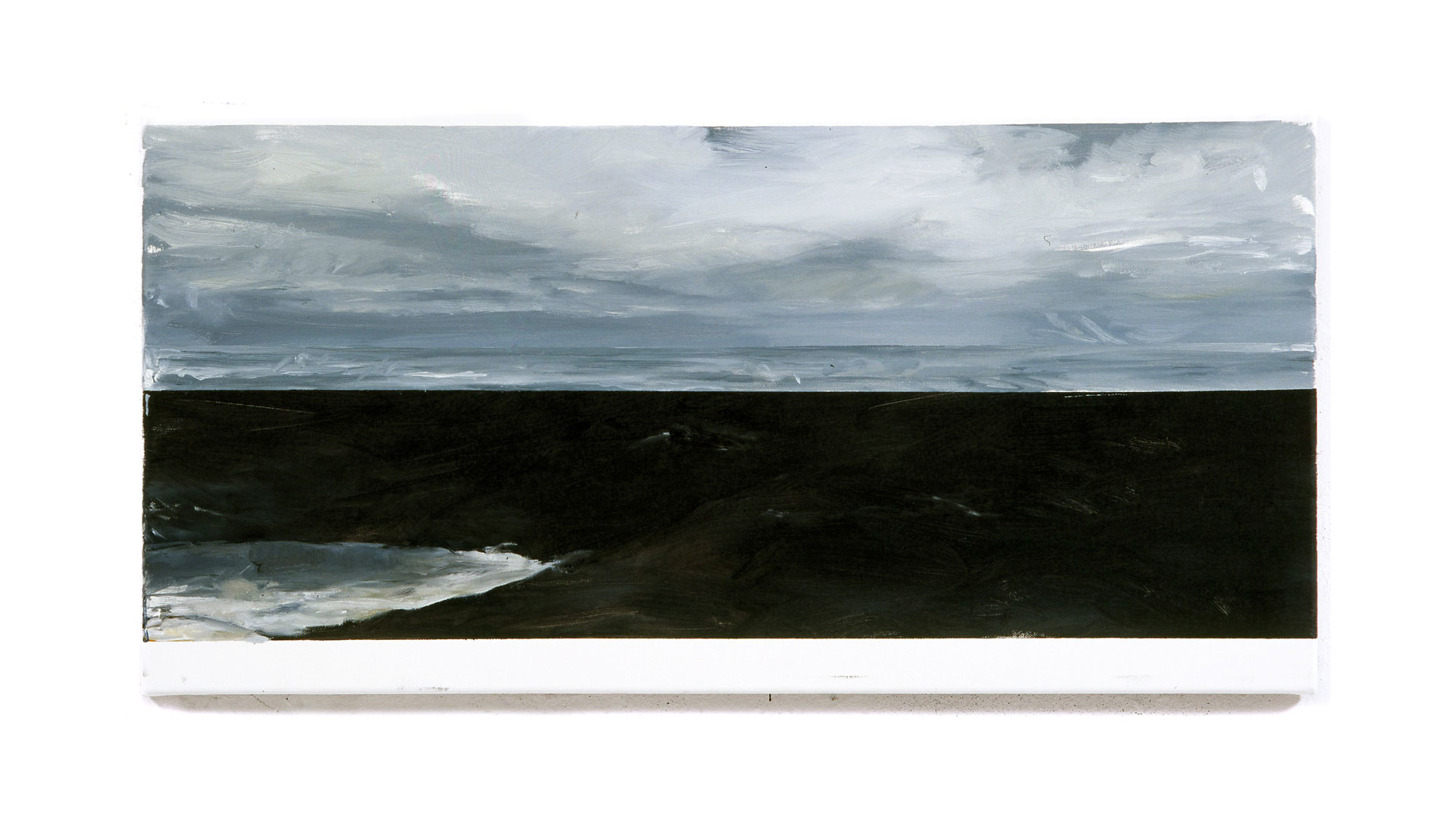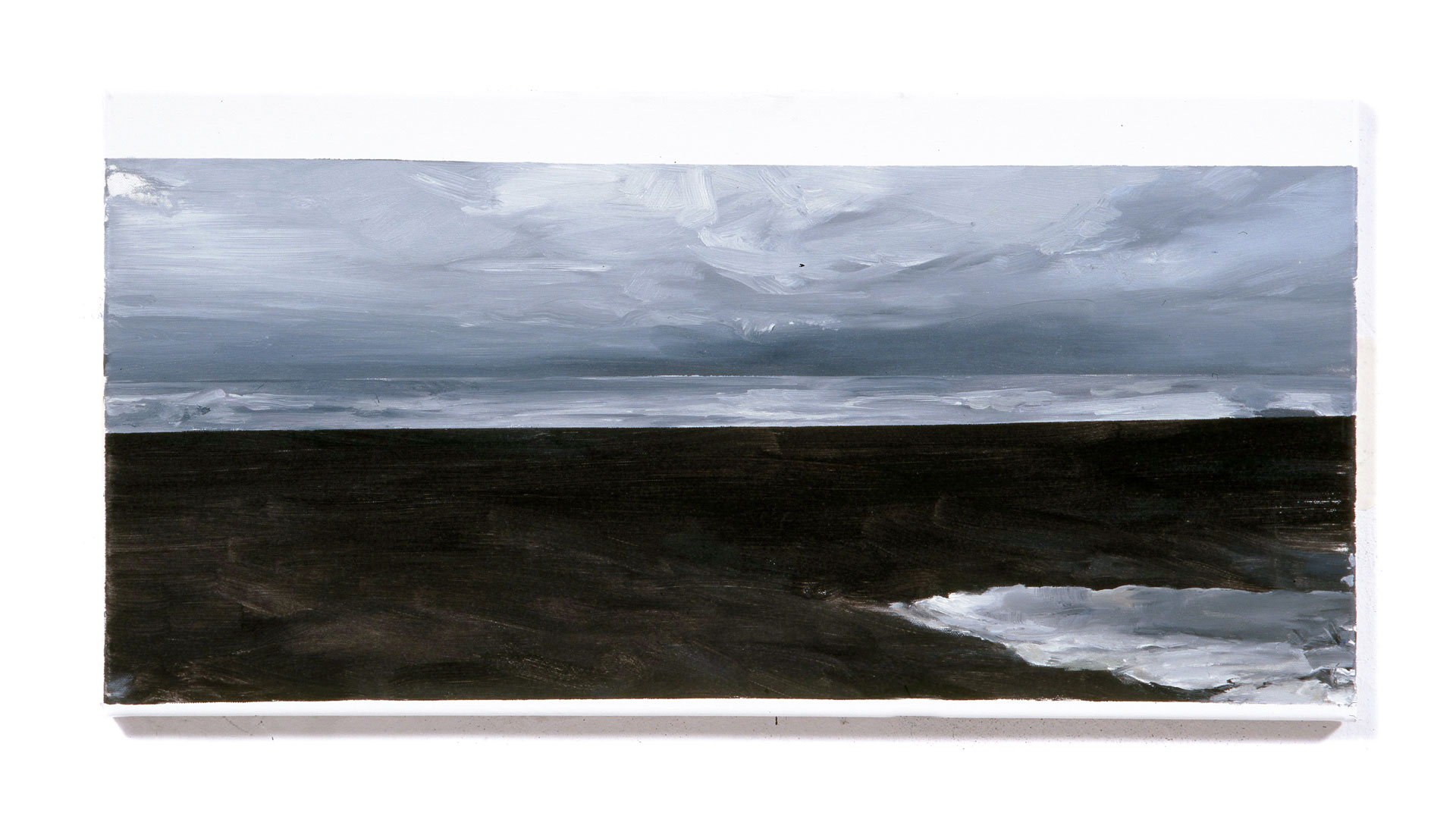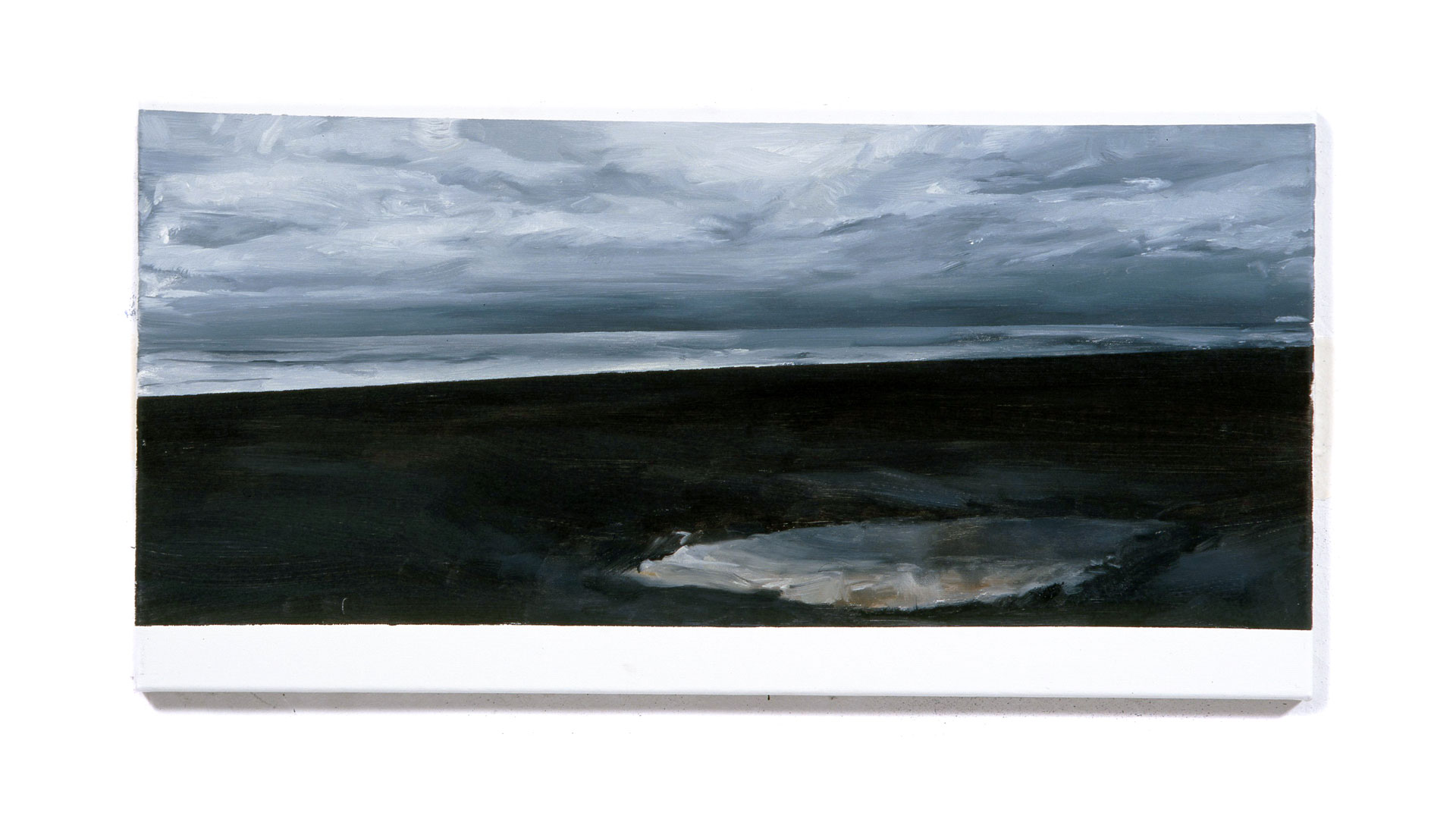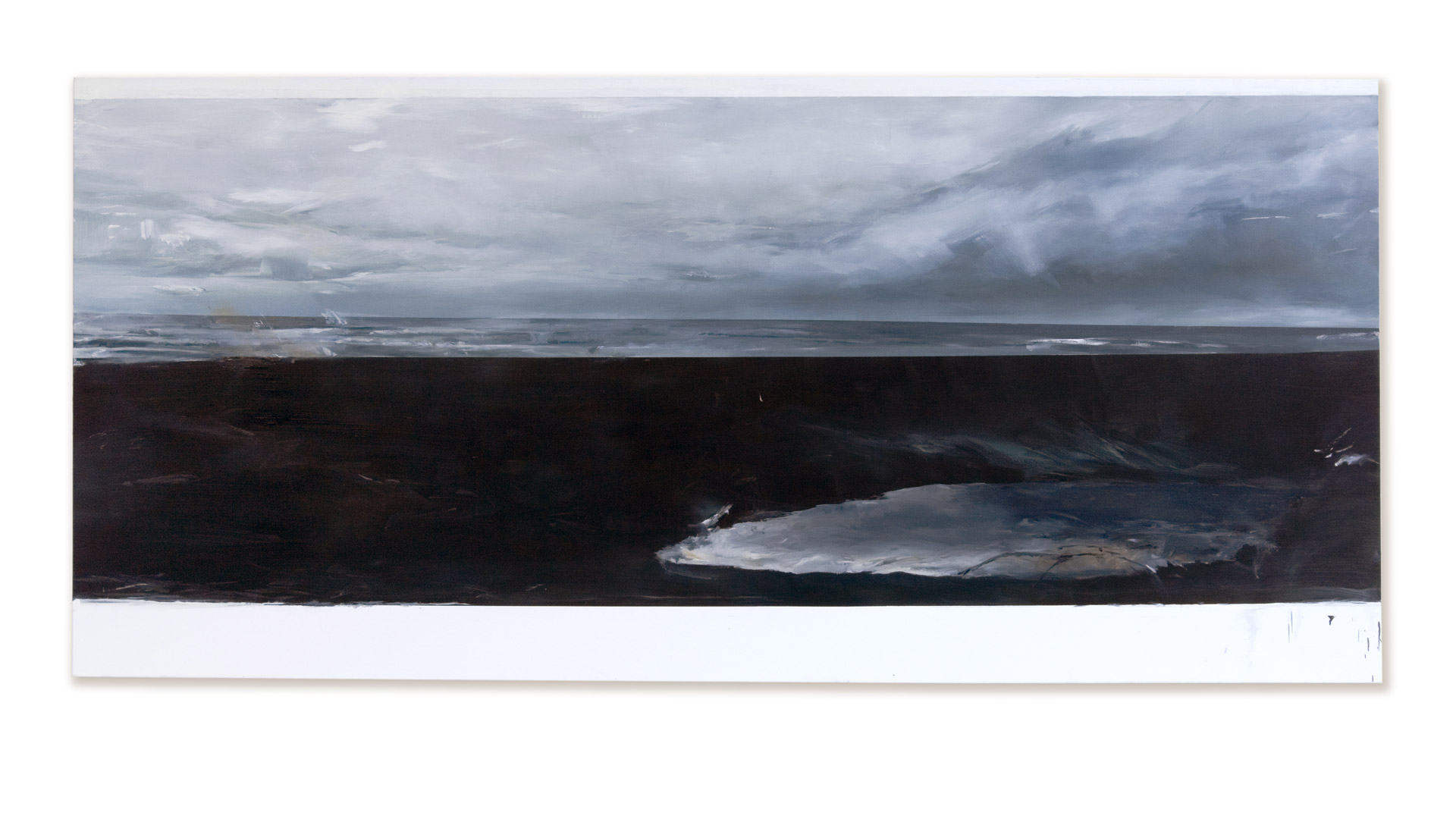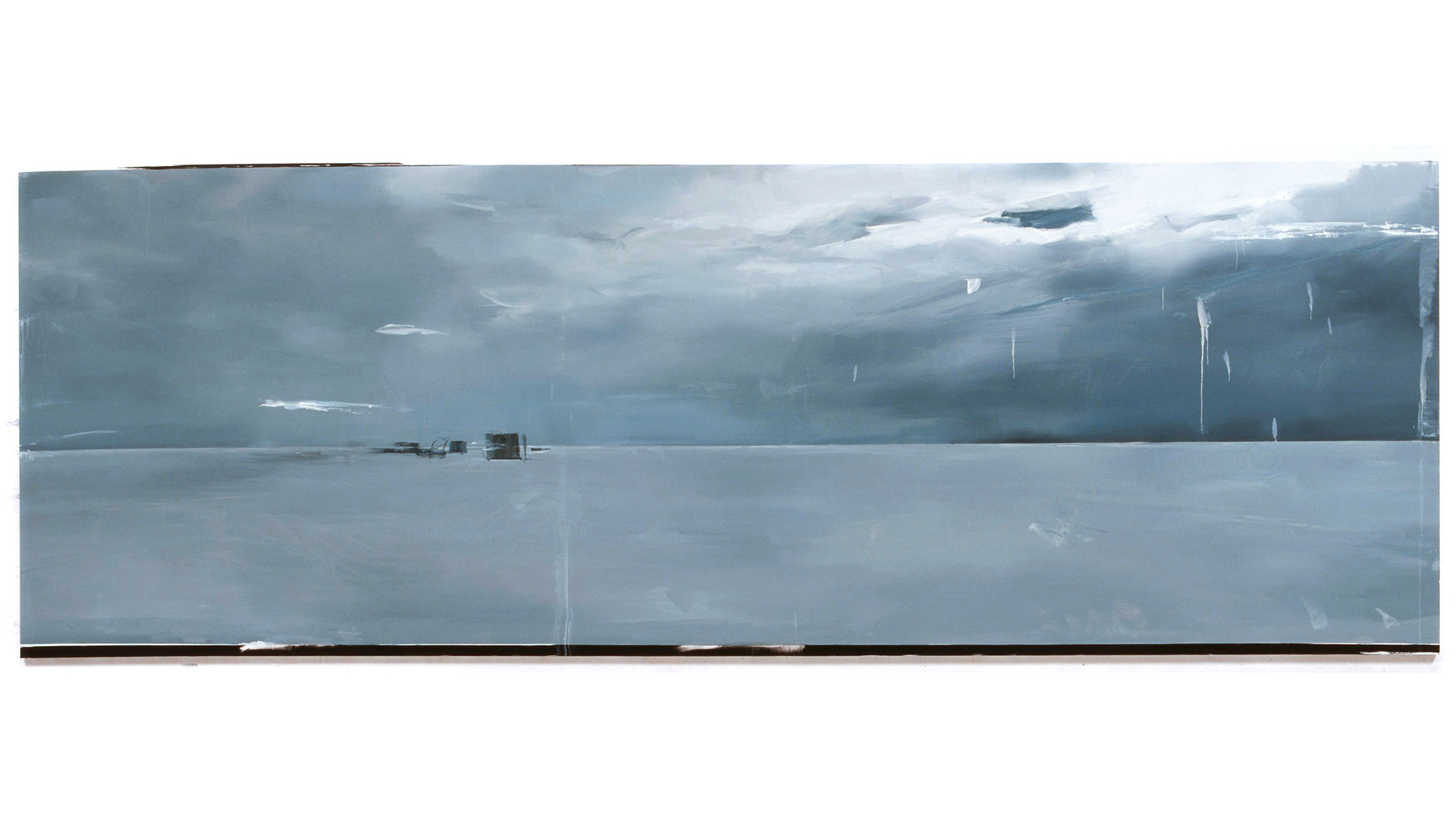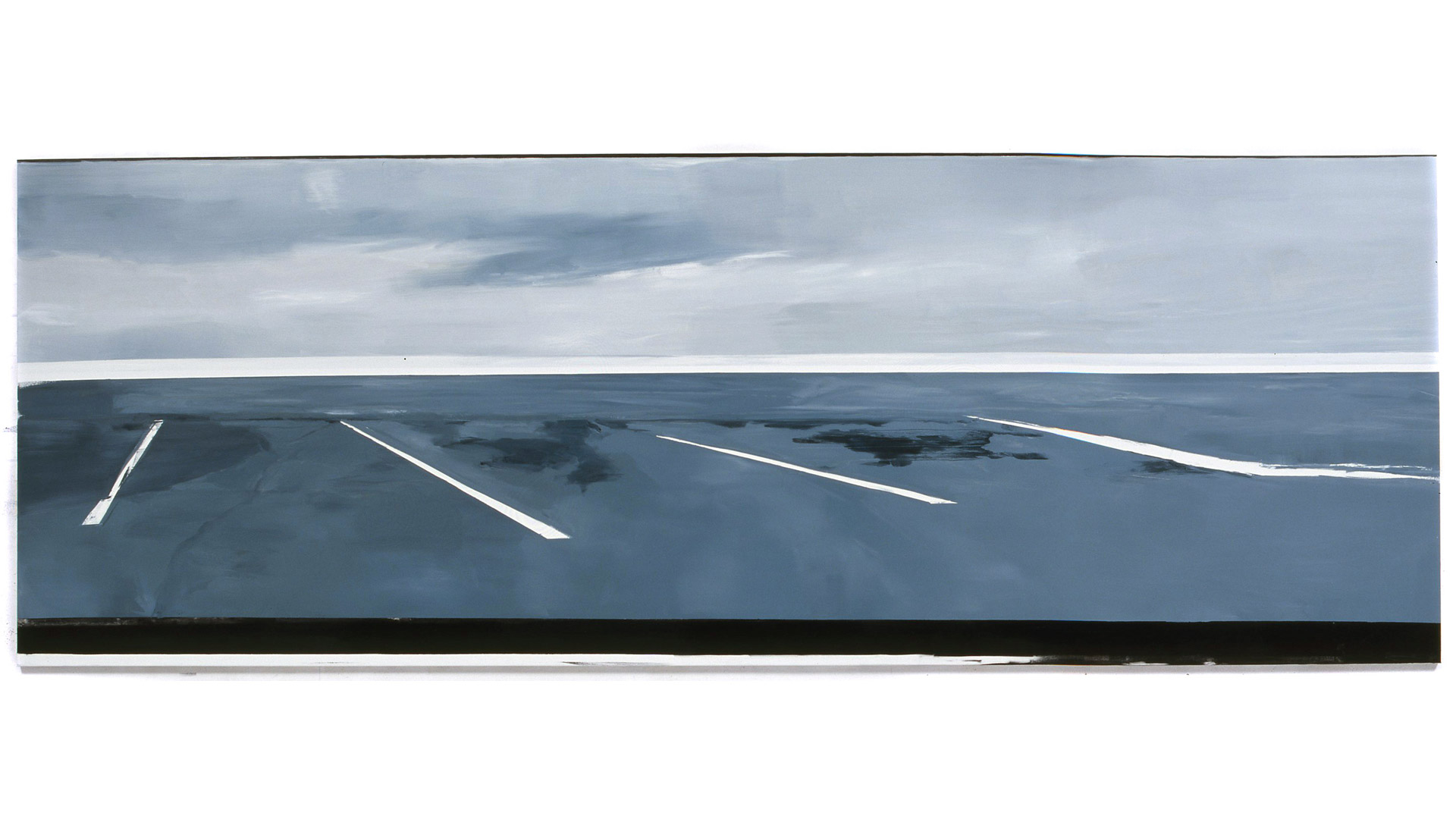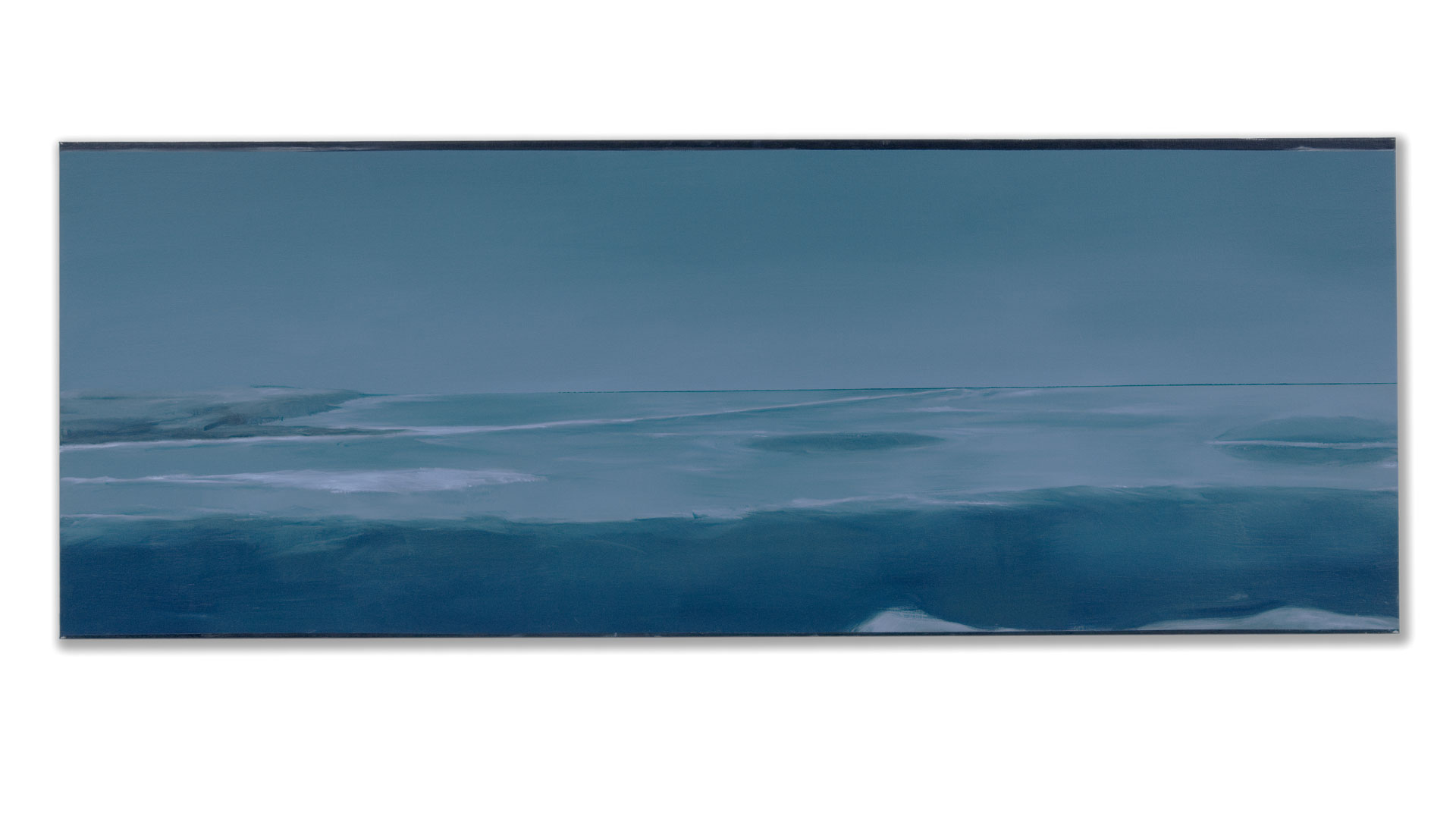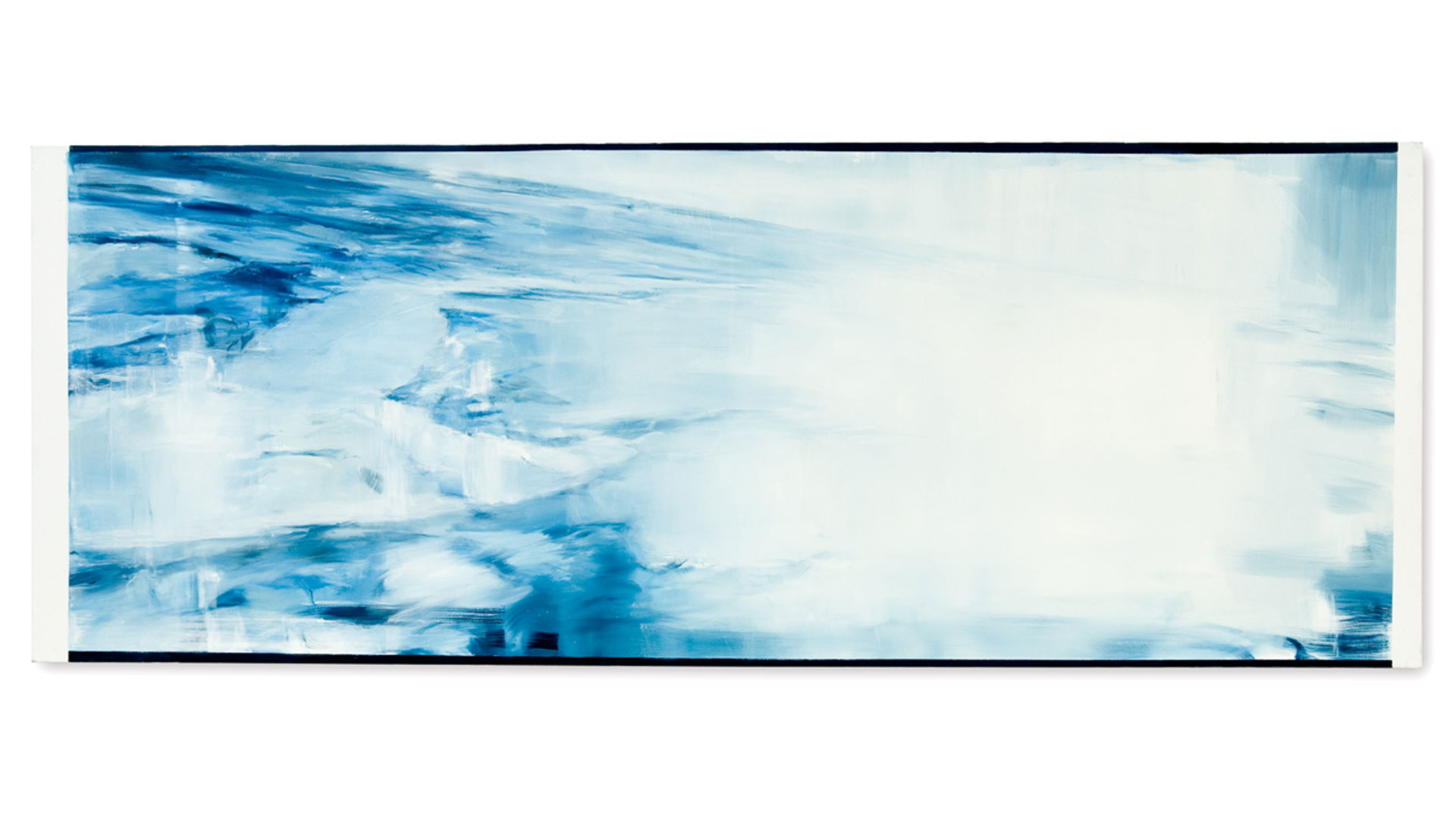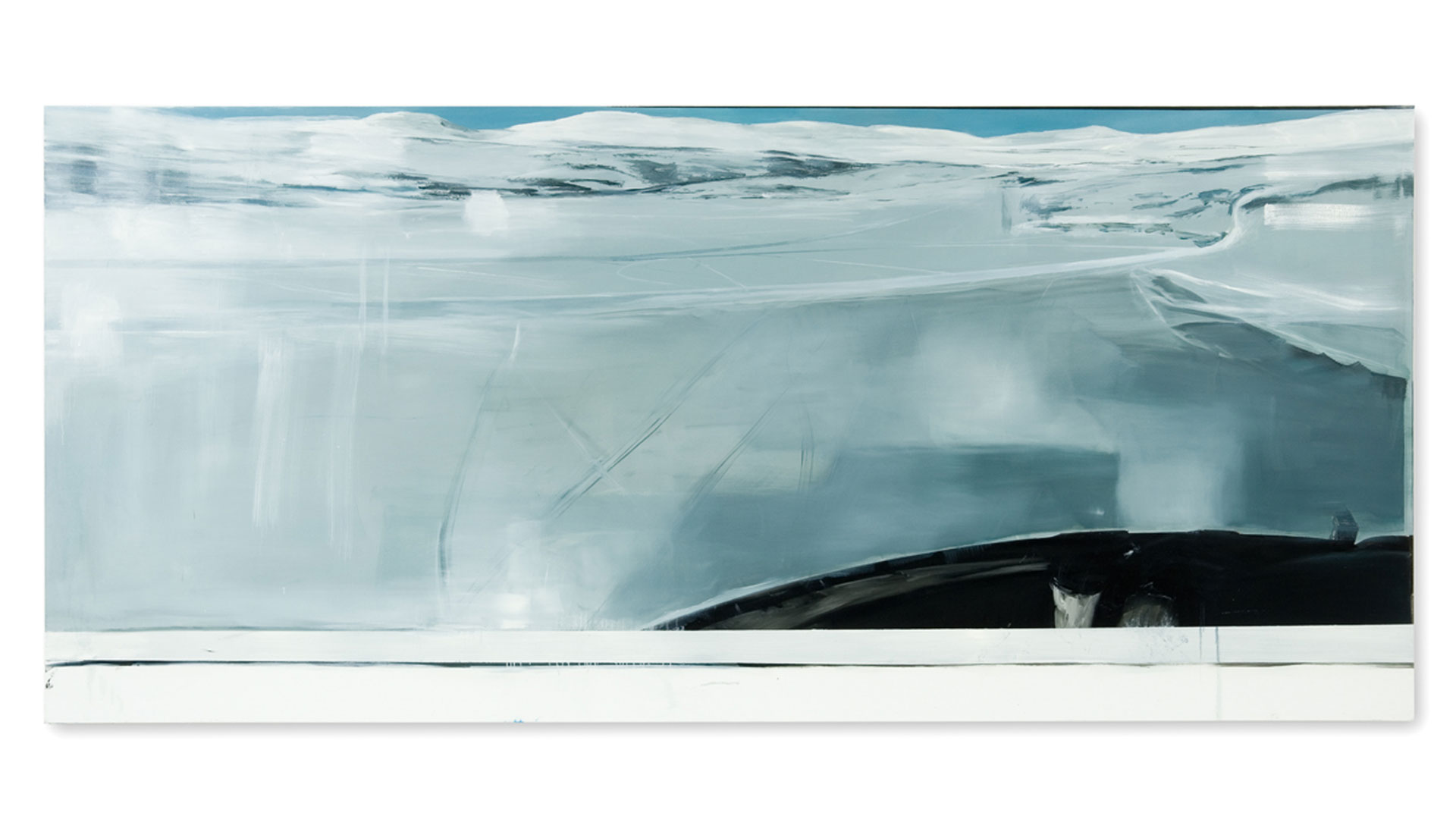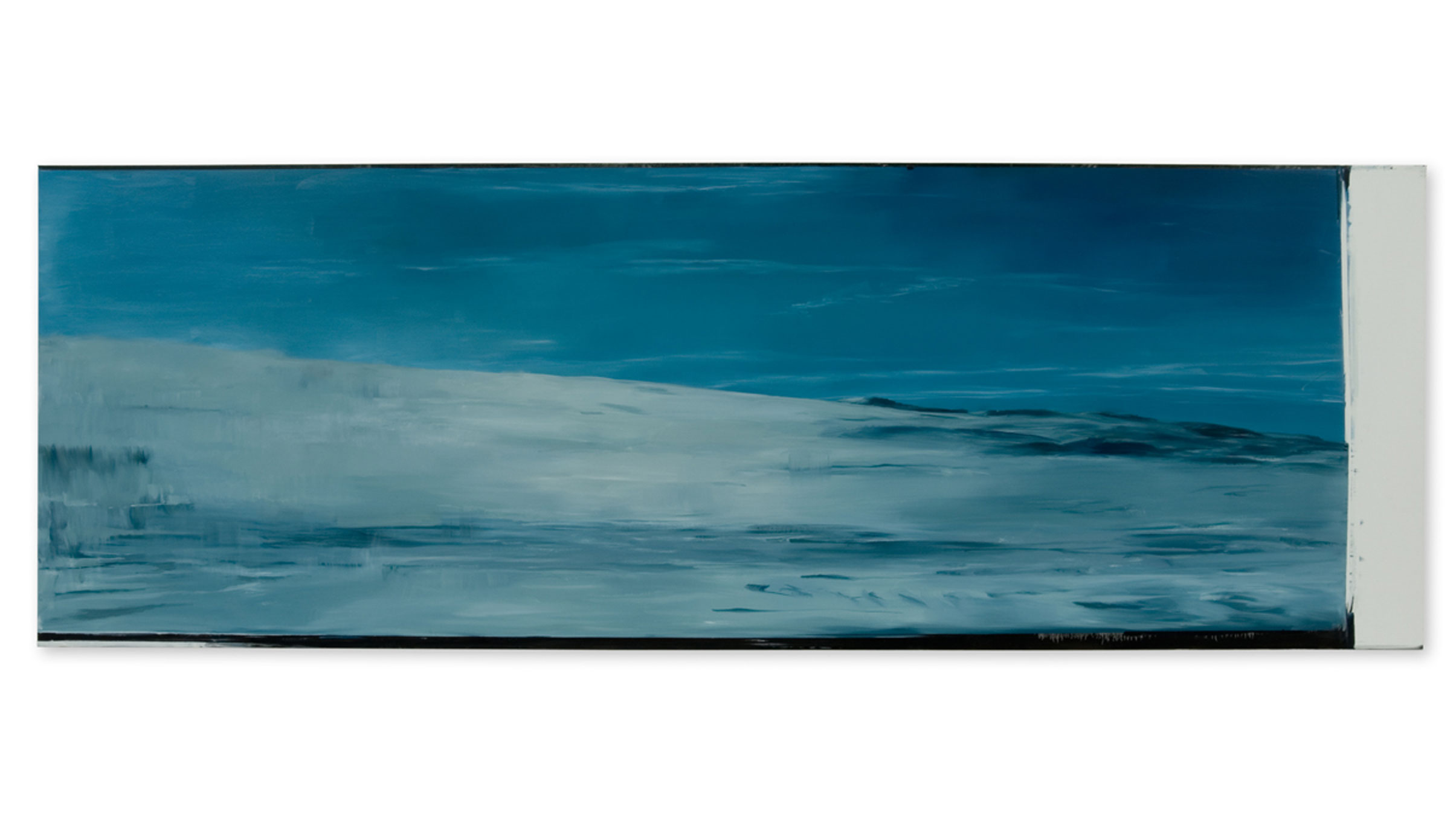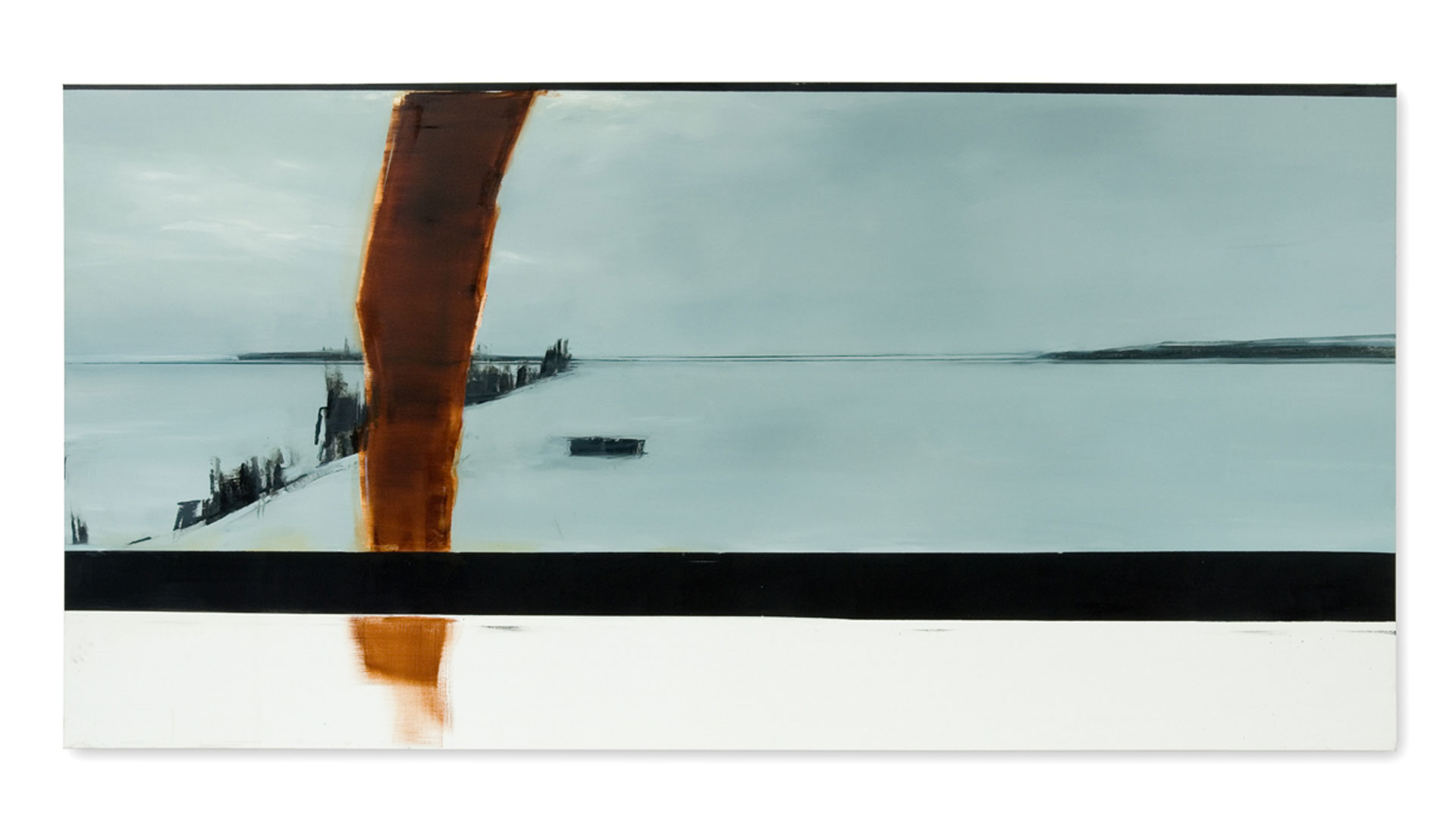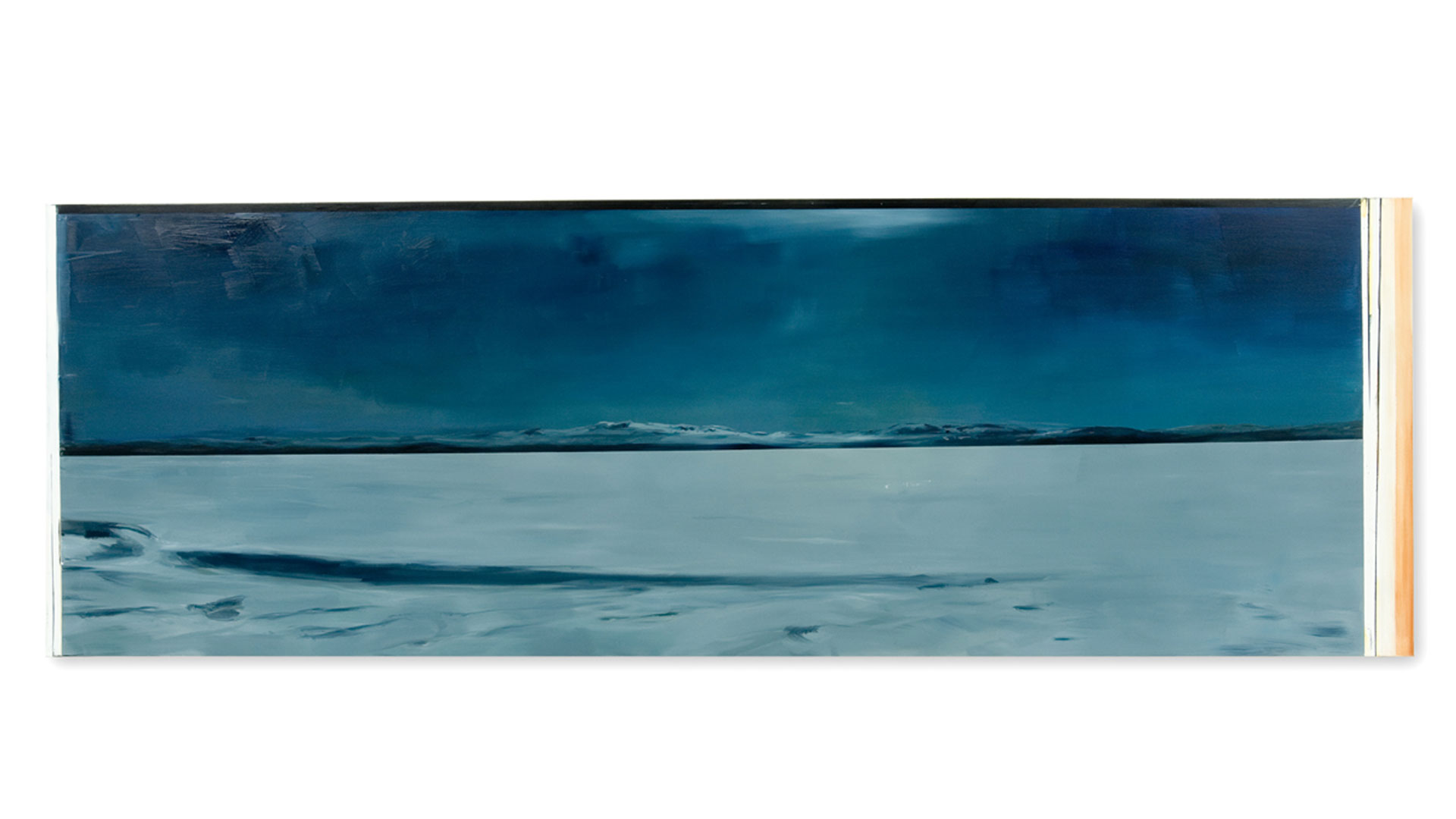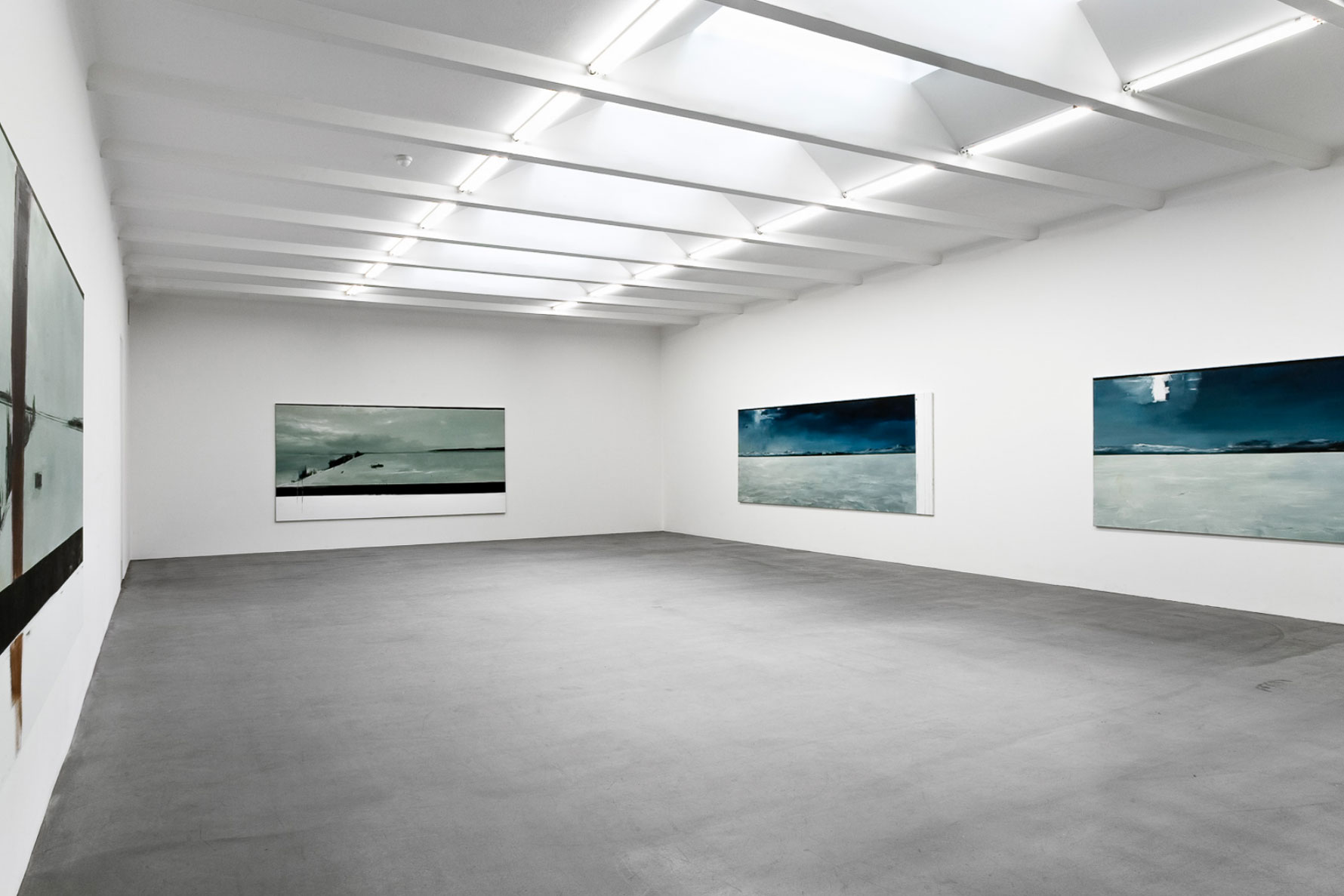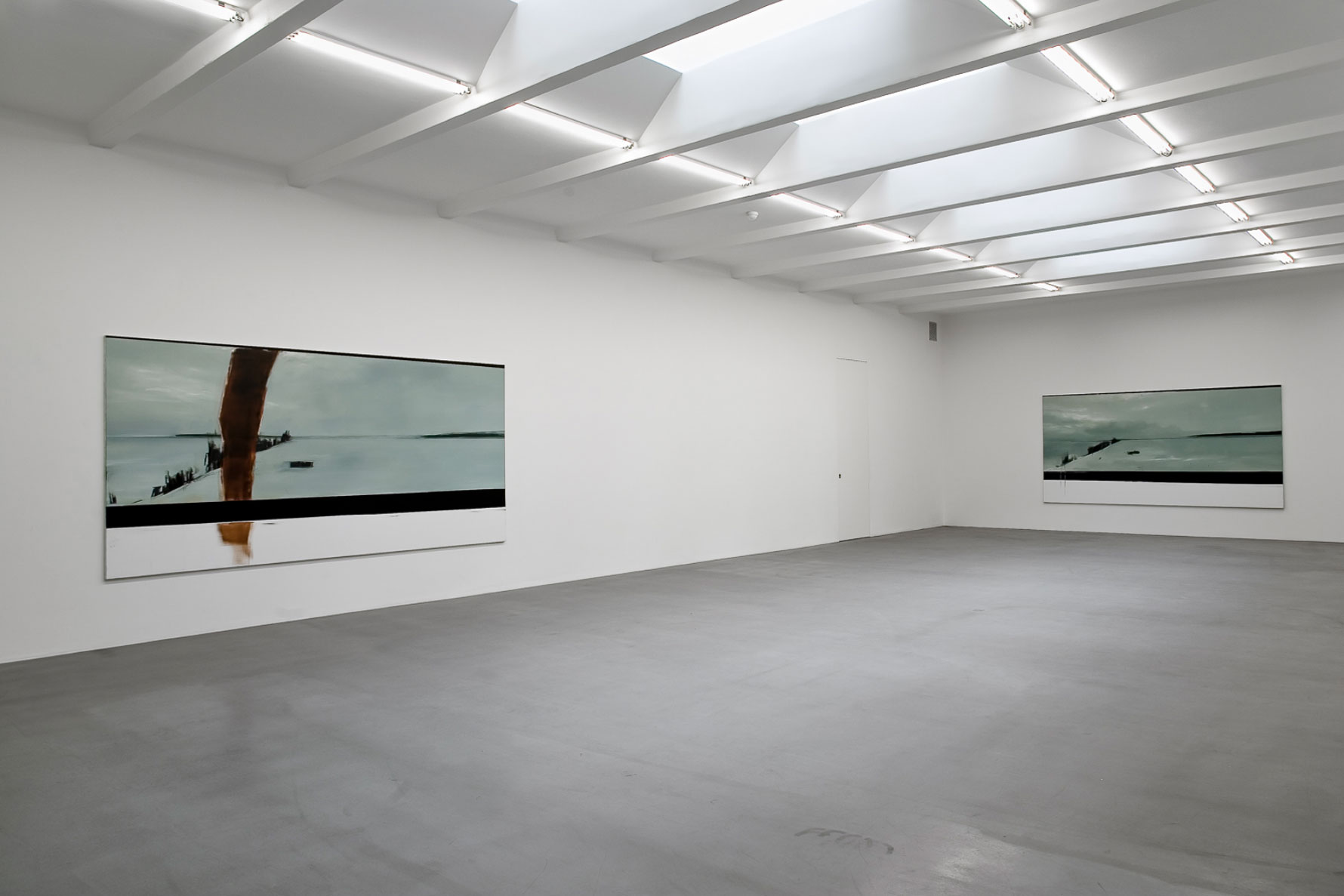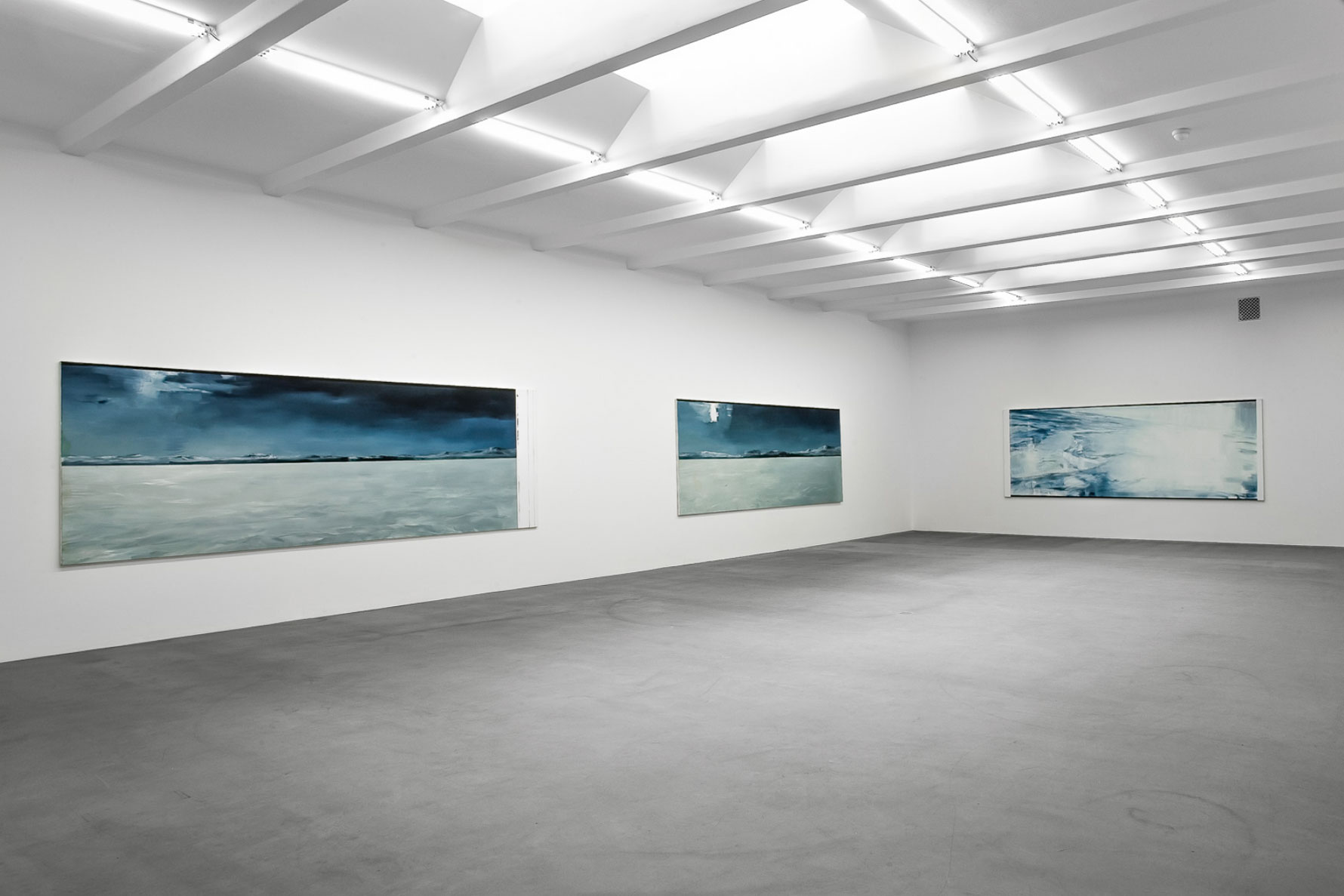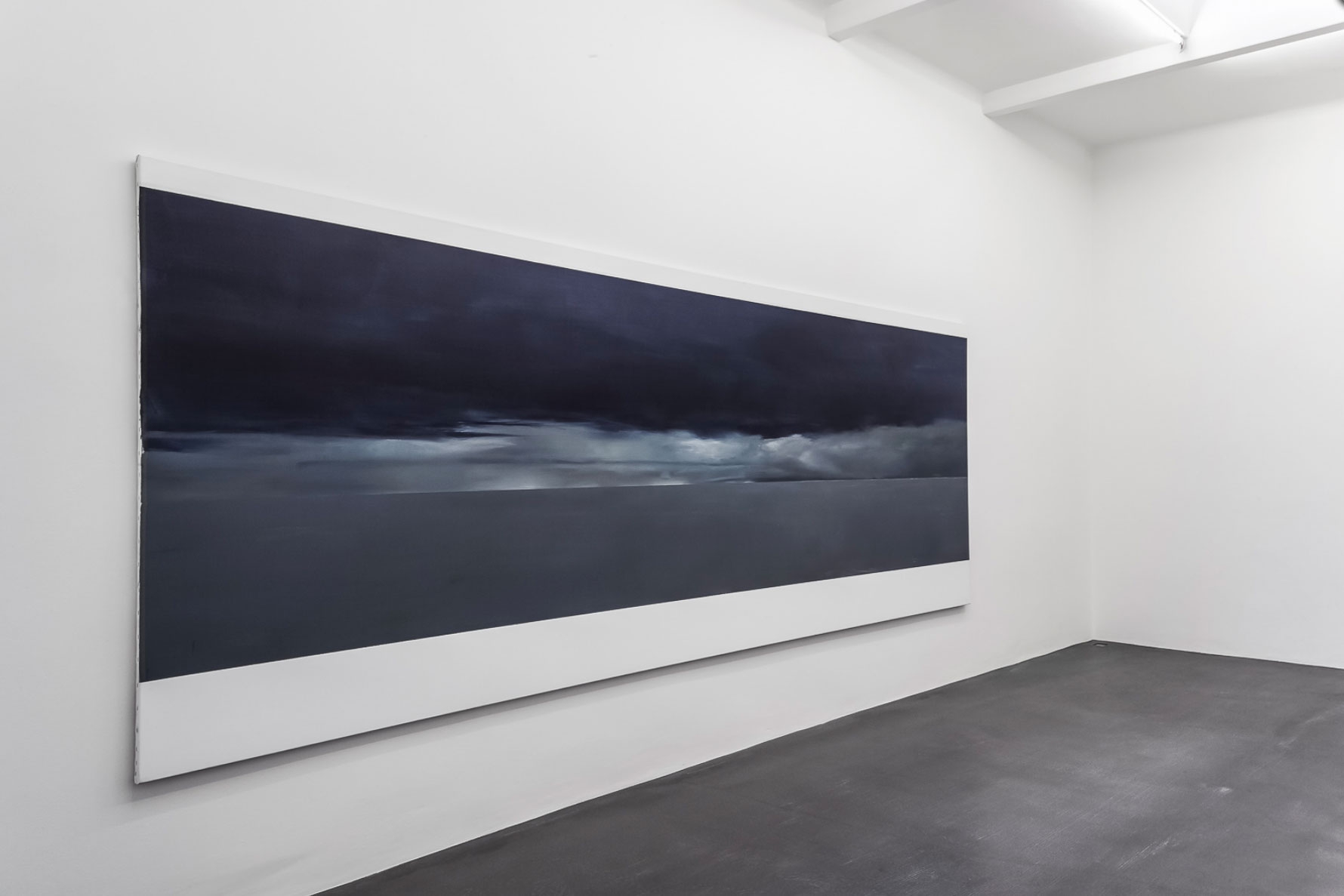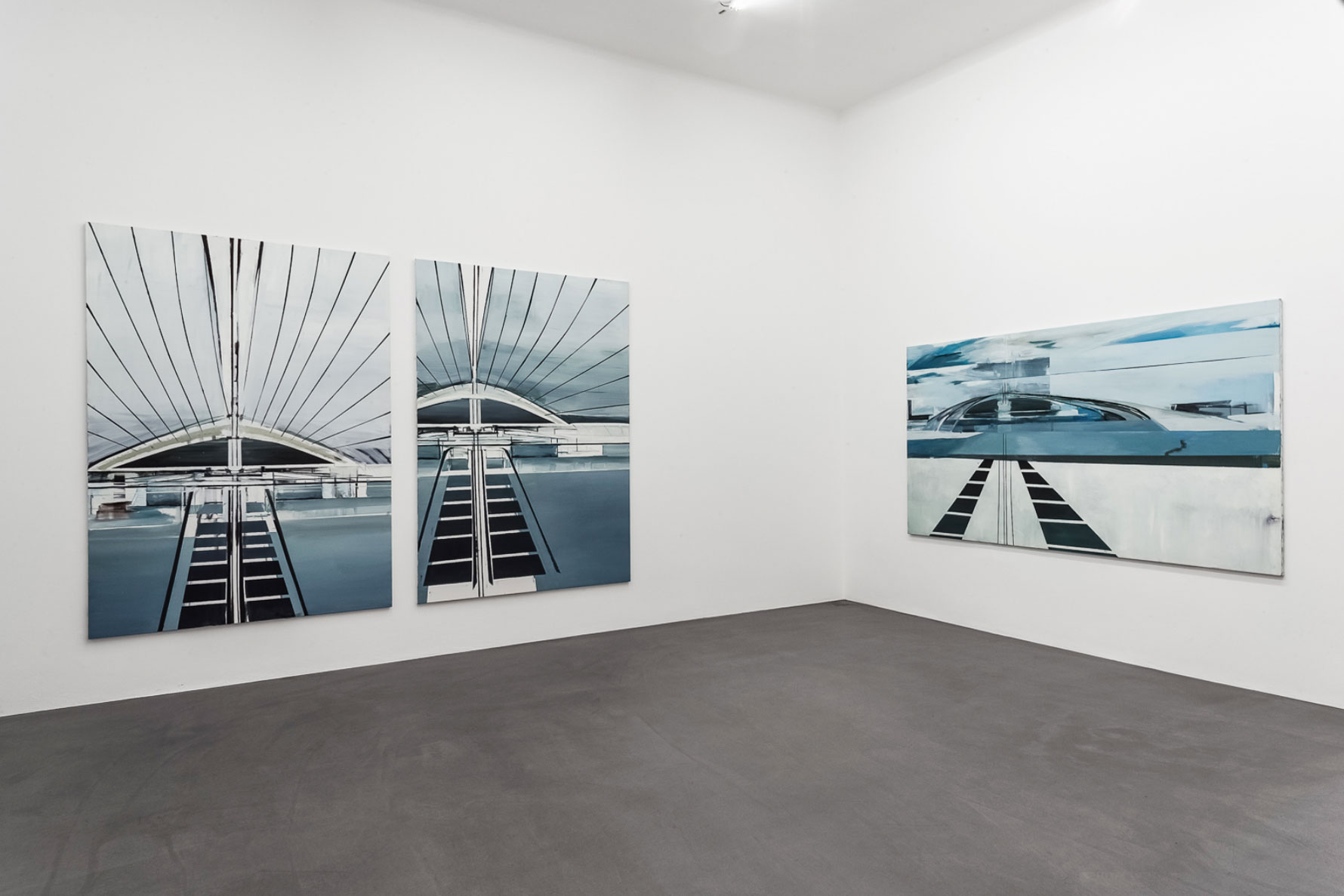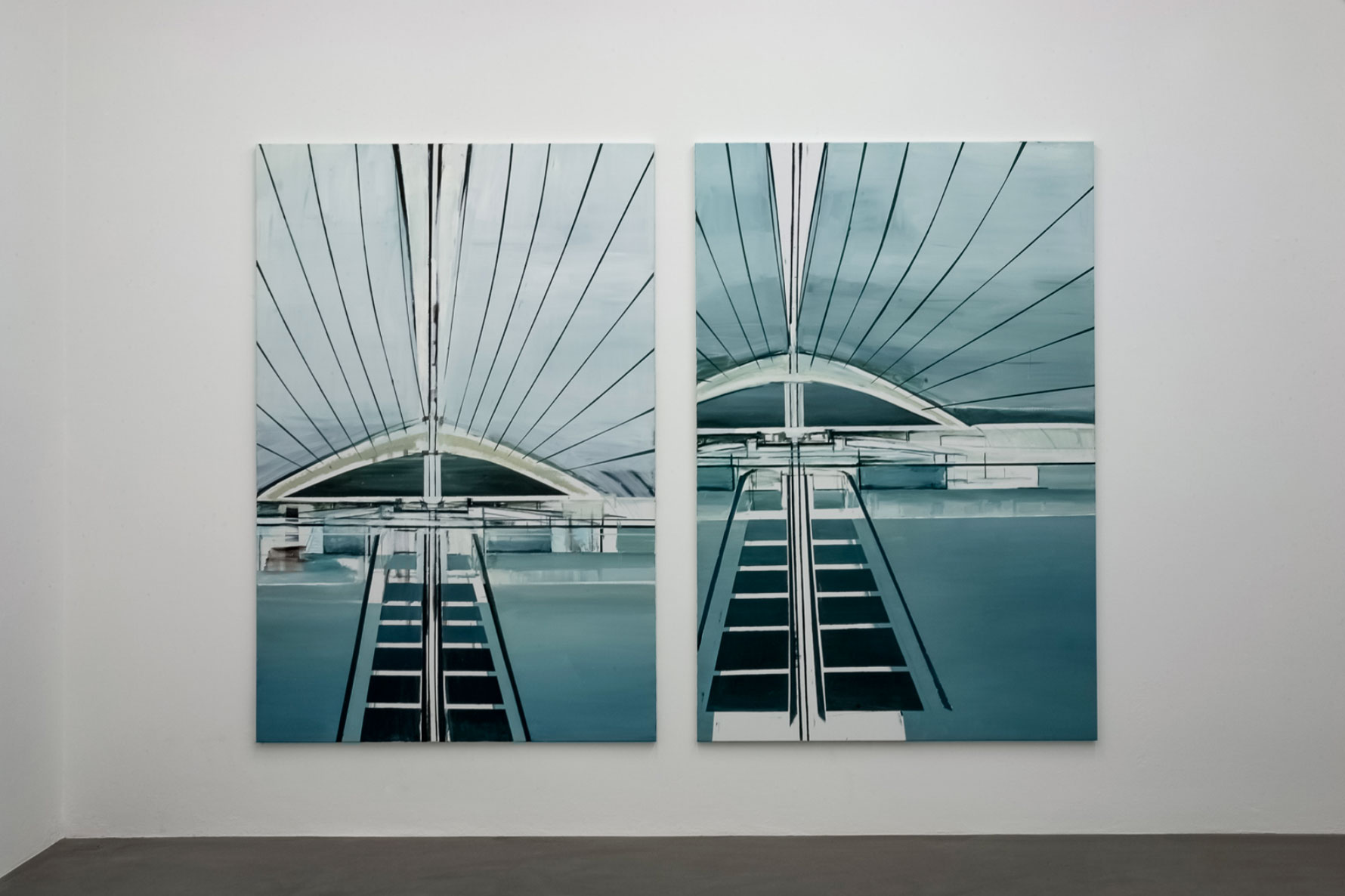2007 – 2006
INSTALLATION at TANYA BONAKDAR GALLERY, NEW YORK
MARCH 31 – MAY 5, 2007
Klein’s initial photograph and its subsequent abstraction represent a layered approach to capturing a moment in time, poetically revealing the levels of mediation that frame our contemporary experience of the world and questioning whether the depiction of “reality” is possible. Each painting illustrates artifacts of the imaging process, which Klein terms the “abstract consequence” of the photo; white borders on the canvas represent the void where the image has been cropped, black lines at the edge of the image suggest the border of the photographic print, and drips of paint reference scratches on the surface of the negative. Prints developed from chemical baths that have been used and depleted produce a melding of color and shape and a muting of tone, which Carla transfers to the canvas; digital shots of night scapes, printed on paper saturated with the printer’s ink, become opaquely black landscapes, impenetrably dark. None of these “imperfections” is intentional, each is a result of the mechanical process of reproducing her shot, but by enlarging and reinterpreting these photographic artifacts on her canvases, Klein points to the impossibility of precise reproduction even in the seemingly most objective media.


THE OBSERVER’S PARADOX by Caoimhín Mac Giolla Léith
January 2007
‘There is a difference between a shaky or out-of-focus photograph and a snapshot of clouds and fog banks.’ A quick shuffle through the heap of photographic prints strewn across the table in Carla Klein’s painting studio initially suggests a blithe indifference to this distinction made by the physicist Erwin Schrödinger during the course of his famous illustration of quantum indeterminacy in 1935.[i] For a start, Klein’s proliferating collection of snapshots seems equally accommodating of blurred photographs of objects and phenomena and photographs of blurry objects and phenomena. Shot on the road during her extensive travels to increasingly far-flung places, and developed personally in the darkroom on her return home, this substantial trove of photographs provides much of the source material for a distinctive body of paintings produced over the past ten years. Klein generally works in series and prefers to work on several paintings at once, regardless of size, which has tended of late toward the large-scale panorama. Her self-consciously reduced and instantly recognizable palette of cool blues, aqueous greens, sombre grays, and snowy whites has over these years proved remarkably adaptable to a wide range of subject matter. This includes, in rough chronological order, the shadowy interiors of natural history museums and terraria, the icy stillness of unoccupied indoor swimming pools, the impersonal functionality of foyers, stairwells, escalators and sundry transit areas, the cold monumentality of contemporary architecture and engineering, and, most recently, the disorienting panoramic vistas of some of the world’s less hospitable landscapes.
Continue reading
Schrödinger distinguishes between an imprecise representation and the representation of that which is inherently unamenable to precise representation, and he makes this distinction in the course of an attempt to address a particular instance of what is generally known as ‘the observer’s paradox’. This concept, which is equally applicable to the social and the physical sciences, suggests that the observation of a phenomenon will inevitably alter its nature, and the attempt to record or measure a process will invariably affect its outcome. Much of Klein’s work might be said to grapple with this paradox, within the domain of aesthetic representation, to the point of rendering it thematic. This is most evident in her gradual, though never total subordination of pictorial content to the mechanics and materiality of what were once perceived as contrasting, if not competing forms of image-making, namely painting and photography, a point to which we shall return. Yet even early on her work acknowledges indirectly the aspirations and limitations alike of empirical observation, scientific interpretation, and imagistic rendition. Klein’s professed interest in scientific methodologies and classificatory systems has been registered in different ways in her work over the years. It is most obviously to the fore in the early paintings of meticulous taxonomic arrays of stuffed specimens from the animal kingdom displayed in the dusty vitrines of various traditional natural history museums. These paintings acknowledge, at the level of form as well as content, the incomplete, inconclusive and belated nature of any attempt to capture or calibrate the reality of the world around us. The bleached and gloomy colours reflect that curious sense of unnatural preservation and incipient decay associated with such institutions: the queasy, antiseptic lighting, the occasionally empty vitrines, the gapped displays of dishevelled taxidermy from a bygone age. The expressive, wet-on-wet handling of paint, the swift brush strokes and apparently casual dribbles, as well as the often rudimentary depiction of the specimens, incidentally remind us that, regardless of the museum’s aspiration to totalizing order and comprehensive presentation, what we are left with in the end is but an imperfect notation of a world that has already passed away. While the individual, carefully preserved specimen can tell us much about the land of the living, it is manifestly no longer of it. As Klein notes, a stuffed animal is both a representative of its species and a unique (and somewhat disconcerting) object in and of itself.[ii] Even the paintings of terraria, those glass cases in which small land animals and plants are kept alive in unnatural conditions for the purposes of observation, empahasize the chilly artificiality of such environments. In many instances they appear to be empty, more redolent of absence than the presence of life. In a comparable manner, the later paintings of deserted swimming pools, airport corridors and departure lounges are, without exception, luminously forlorn. They are bereft of the people who might ordinarily animate such ‘non-places’, to use a term coined by Marc Augé, which has, perhaps inevitably, been invoked in previous accounts of these paintings.[iii]
A crucial aspect of the non-place is its relative inhospitality, and this sense of the inhospitable continues to inform Klein’s choice of subject matter up to the present day, even as she addresses natural landscapes more typical of the tradition of the romantic sublime than the artificial spaces of what Augé calls ‘supermodernity’. If space, for Michel de Certeau in The Practice of Everyday Life, is largely a matter of ‘frequented place’, defined by ‘the intersection of moving bodies’, Klein’s current interests clearly lie elsewhere, in the exploration of places that are unfrequented almost, if not quite, to the point of inaccessibility. Her most recent, specifically commissioned suite of large-scale panoramic paintings is a case in point. These pictures present us with various views of the intimidatingly harsh winter landscape of Rensjösätern in the Jämtland region of central Sweden. This project has its roots in an earlier body of work resulting from a lengthy road-trip Klein made in 2004(?) across the United States of America. In fact, a number of her paintings from early 2005 of the vast, disquieting expanses of the Salt Lake Desert in Utah, are informed in turn by an earlier encounter still with the frozen wastes of a region of Finland north of the Arctic circle, which Klein visited in 200(?). She made her brief trip to Finland with the intention of eventually producing a series of paintings depicting the changes wrought over time on this forbidding landscape by seasonal variations of light and climate. While this project remains unrealised, it anticipates in essence the paintings of Rensjösätern. Of course, in some ways the sun-blasted, dried-up vistas of the desert may be seen as the exact opposite of the freezing, light-deprived Arctic tundra. Yet, from a painter’s point of view, they share considerable common ground. Both of these virtually uninhabitable, physically discomfiting, and visually disorienting landscapes present a comparable challenge to the process of depiction. The question they pose is how might an artist take effective pictorial measure of the effectively incommensurable? While the landscape of Rensjösätern in the summer months may display the comforting contours of recognizable and navigable terrain, the winter snows render it both visually intractable and physically demanding for those familiar with it, and downright dangerous for those who are not. In order to fulfill the requirements of the commission Klein had recourse to an expert local guide, specialized clothing and exotic forms of transport including a snowmobile and a helicopter. The emphasis on inaccessibility, which was already signaled by the locked or empty vitrines, the unpeopled swimming pools, and the evacuated architecture is, quite literally, amplified by these bill-board scaled paintings of wide open spaces, of harsh environments that are largely resistant to human inhabitation.
By rising to the challenge of producing painted images of such physically inaccessible landscapes Klein throws into sharp relief certain qualities and limitations inherent in different modalities of pictorial representation. In order to bring these to light it is worth returning to the question of contemporary painting’s vexed relationship with photography. Klein is by no means unusual among her peers in her use of photographic source imagery. For instance, the recent admixture to the resources of contemporary painting of images of scientific provenance, previously inaccessible but newly available through advances in microscopic and telescopic technology, has greatly enhanced the lexicon of contemporary abstraction. However, Klein’s preferred source imagery remains essentially in the domain of the amateur tourist snapshot, despite the fact that these images are produced by a skilled and self-conscious artist. She is also unusual in the degree to which her painting emphasizes the mechanics of photographic reproduction as much as the accidence of painterly execution in the completed image on canvas, especially in this most recent suite of paintings. These paintings pointedly call attention to the multiply mediated nature of the imagery they present. The myriad imperfections we commonly associate with the casual production, inexpert development or careless handling of everyday snapshots are laboriously reproduced and accentuated by hand as an integral part of large-scale paintings destined for formal presentation in a gallery context. Blemishes are literally blown out of proportion, ‘mistakes’ are writ large. In various different works Klein carefully reproduces the scratches, stains and smudges that can mar the surface of a photographic print, the deleterious effects of electronic corruption on a jpeg, the fuzzy indeterminacy of low resolution imaging, the botched effects of misprinting, and the distractingly blank white margins produced by printing on standard sizes of photographic paper. Her decision to do so reflects a belief that these apparently accidental and extraneous aspects of the photographic image are all, in her own words, ‘part of the image’. In the painter’s eyes, they are literally part of the bigger picture. Klein’s painstaking simulation by hand of a plethora of deformations more proper to photographic reproduction, mechanical or electronic, brushes against the grain of an increasingly fluid painterly technique historically and conventionally associated with gestural expression. This is in keeping with her stated objective ‘to produce a layered form of painting where oppositions and contradictions are accommodated’.
The play-off between painting and photography is just one instance of this hospitable attitude to ‘oppositions and contradictions’, which in itself may be ironically contrasted with the lure of the inhospitable, in terms of subject matter, to which we have already alluded. The play between space and time, the spatialization of the temporal and vice versa, is also an increasingly significant aspect of her work. Klein’s unrealized Finnish project was based on the idea of returning to the same spot at different times of the year and photographing the same view, thereby registering in the resulting paintings certain changes over time. The Rensjösätern paintings, on the other hand, involved traveling to various spots in the same general area in a relatively short period of time, and photographing them from various perspectives, including that of an airborne helicopter. Even on the ground, multiple perspectives were deployed. As Klein has noted, ‘I like to paint paintings from a series of photographs that I take seconds after each other. I am dealing with stillness and movement in time – these frozen seconds…with the way reality and atmosphere changes with every movement of the horizon, as I move to the left or to the right with my camera.’ Of course, while ‘reality and atmosphere’ can change according to shifts in spatial or temporal perspectives, the representation of that ‘reality and atmosphere’ can also be manipulated by various technical means available to the photographer, either in situ or later in the darkroom, long before the painting commences. The related questions of mutability and mediation thus attain comparable significance in these works.
Given Klein’s characteristic readiness, one the one hand, to inscribe into a given painting various accidental or extrinsic aspects of the photograph from which it is derived, and, on the other hand, her willingness to alter at will certain features of a given ladscape on purely formal or compositional grounds, the question recurs as to how to characterise the relationship between the empirical reality of a particular place and its representation in the painted image. In the exceptional case of the Rensjösätern paintings the constraints of a private commission were such that the landscape needed to be recognisable, at least to anyone familiar with the location. While Klein is happy to respond to the specifics of the landscape in front of her, and as it subsequently re-presents itself to her in the form of a heap of snapshots on her studio table, she admits that she has little interest in specifics per se. An undue concern with the particularity of a real-world scenario might hamper her desire, as she puts it, ‘to work abstraction against the image’. The paintings of the Salt Lake Desert and the Rensjösätern series come closer, both in form and content, than the earlier works to the tradition of the romantic sublime, including the abstract sublime. For instance, the white margins of these canvases, though derived from a photographic model, recall the ‘zips’ of Barnett Newman, for whom, famously, ‘the sublime is now’. Yet the insistence on seriality, on repetition and difference, confounds this tendency somewhat and suggests a different perspective again. Given what Klein has referred to as the ‘semi-scientific’ aspect of her approach to painting, we might conclude with a suggestive analogy from the scientific domain invoked in the opening quotation. The theory of ‘superposition’ in quantum physics supposes, however contrary to common sense and casual observation, that an object can be in multiple, infinite or even contradictory states simultaneously and that it is only the insistence on measuring it that limits its possibilities and fixes its state. Perhaps something similar can always be said of the artist’s attempt to capture the elusive reality of a physical world that will forever lie beyond conclusive comprehension and precise representation.
Caoimhín Mac Giolla Léith, January 2007.
[i] Erwin Schrödinger, ‘Die gegenwärtige Situation in der Quantenmechanik’, Naturwissenschaften 23 (1935): pp.807-812; 823-828; 844-849. The opening quotation is from a translation by John D. Trimmer, which can be accessed at www.tu-harburg.de/rzt/rzt/it/QM/cat.html.
[ii] All references to the artist’s observations on her work relate to the interview on pp.?? of this publication.
[iii] Marc Augé (trans. John Howe), Non-places: Introduction to an Anthropology of Supermodernity (Verso, London and New York 1995), See, for example, Anke Bangma (trans. Nancy Forest-Flier), ‘non-places’ in Carla Klein (Artimo Foundation, Amsterdam 2000) pp.59-61.
Caoimlín Mac Goilla Leíth in conversation with Carla Klein
January 2007
The use of photography and the processes and accidents involved in various forms of photographic printing are fundamental to your working method as a painter. Could you talk a little about this?
My use of photographs in painting comes from wanting to paint facts, not fiction. I use photos, in a way, to paint the way you see things in an abstract manner. So, by using photos and showing something of the process of photographic development, I can paint both the image and the non-image. I often incorporate into the paintings various “mistakes’ that occur during the development process. These include ‘mistakes’ that occur while taking the photo and while scanning the negative, as well as all the deformations that can happen while processing an image. I also use computerised faults and accidents: for instance a corrupt jpeg, a misprint, and very low resolution images, all the things which are not ‘manmade, but which are changed by a machine or during the ‘mechanical’ process of production. Using these elements gives me the opportunity to devalue the image in the painting, combining the image and the process by which it is made, and saying something about the complex nature of how we view the world. This gives the paint itself and the painting a more important role, by not only referring to what you see – the ‘realness’ of a landscape, a swimming pool, an interior and its faraway horizons – but playing with different or opposing aspects of paint, image and the painting itself, such as the size of the painting and the material reality of a canvas, The shortcomings and the realities of the different processes are reflected in the use of the paint, the sizes and serial organisation of the paintings, and the combinations of different paintings in one show.
Continue reading
So this is what I want to accentuate in the painting, I’m trying to abstract reality, and trying to produce a layered form of painting, where contradictions and oppositions are accommodated and merge into one overall result. These layers include the painting itself, its sculptural aspect, the image, the photographic print through which it is mediated, the abstract quality of the picture, and the whole process of trying to grab reality, By doing so something different is produced, which not only reflects that reality, but at the same time says something about the choice of context, representation and framework That’s why I like to paint paintings from a series of photographs that I take seconds after each other. I am dealing with stillness and movement in time these frozen seconds (just like the video stills and TV stills which I sometimes use as well) – with the way reality and atmosphere changes with every movement of the horizon, as I move to the left or to the right with my camera. While the image is from the same source, from the same general location, the outcome will be completely different. I use the white borders in paintings also to point out the strange way standard sizes work. When you bring your photos to the shop to develop, the size of the photographic paper is not the same as the size of the negative, which I find really strange and (somewhat) annoying, because I don’t see the reason for the variation/ difference between the two. That’s why I started to develop the photos myself. But, also, in the range of photographic papers available the same standards occur. If you fit the whole negative onto the paper you will end up with a stripe/or stripes of unused paper. At least when I do it myself I have the whole image I took, and the whites are in a way (part of) the consequence of acquiring that image. The way I see it, this part of the photo went through the same process of being lit in the dark room and developed in chemical baths, so it is really part of the image as a whole. And again it adds a degree of abstraction to the image, the abstract consequence of the photographic image. It indicates something of how you are sifting through reality and trying to capture it all. You see standard sizes everywhere: A4 paper, 10× 15 holiday snaps, wide screen televisions and so on. A lot of these formats have white, or black borders around the images, as if the size is not right, or you don’t have the right equipment to see it as it was supposed to be, and it changes the way an image looks /is.
Your fascination with natural history museums suggests an interest in taxonomy and the archive. How is that reflected, if it is indeed reflected, in your recent work? Does the repetition in series of a particular landscape viewed from slightly different perspectives stem from this same taxonomic impulse?
The way you archive, as you try to make an order in the world, to preserve and to conserve the present, is reflected in natural history museums, and in the depots and storage spaces of these museums. The material in the archive, when it is displayed, ideally shows all the known variations of the same species, the overlaps and the differences. This material is grouped together and separated from the outside world. In photography the same thing is involved. You are trying to preserve and to conserve your environment, to understand it and to systemize your surroundings and give them also a place in time. What photography does is to create a different reality. By trying to capture an immense space you end up with a piece of paper. The same thing happens with taxidermy. Most of the qualities and characteristics of the subject (stuffed animals, insects, organs) have gone. It represents its species, but at the same time becomes an object that stands for what it is itself. It has been taken from its normal environment and placed in another order of existence and representation. Another overlap between the archive and my way of working is in the production of series of photographs, the repetition of almost the same landscape, almost the same photograph, but each slightly different from the other – variations of the same in order to emphasise similarities by showing differences. Or you can turn this around as well and talk about how the same thing represented in different ways becomes à different thing, It is all a question of presentation, re-presentation and representation.
How differently do you view the painting of architectural spaces and the depiction of the landscape? In both instances, after all, the subject matter carries a rich freight of art historical precedent.
I don’t see a lot of difference between the two subjects. Both are environments or places that you almost cannot imagine, but do exist. Both are nonhuman in a strange way in that they are not really liveable in or even, fundamentally acces-sible. You’ll find this with the swimming pools as well. They are weird, closed-in environments with no other references then to themselves. With the architectural spaces it is more about the way you don’t seem to see these environments. You just pass through them. And maybe because you are so used to these kinds of places they all just look the same, as there is no hint as to where they are. After all, you are going to find similar spaces elsewhere. These transit areas also have a resemblance to the spaces which play a big role in science fiction. When you are in transit you’re nowhere. When you’re driving through a landscape it is a bit different, but you are rushing through this as well. Going from one desti-nation to another. You can stop and get out of the car on the way, but there will be no change. You’re still just on the road. The surroundings are still basically in-accessible, at least the landscapes I’m drawn to. There is no other way than the road/direction you are taking, and by seeing with the eyes of a camera, the fabri-cated distance makes it a ‘real’ place. ‘This is where I was’. Yet at the same time thecamera becomes the observer who is just seeing and registering what is there, without saying anything about the reasons for being there. The abstraction of the landscapes becomes clearer through the photos and the method of printing.
How would you describe your relationship to art history? How do you view your own painting of the landscape in relation to, let us say, the tradition of the romantic sublime including the abstract sublime?
I love the overwhelming nature of Minimalism, of abstract art and of art that uses scientific methods, or rules, or classificatory processes to produce art. I love the work of Walter De Maria, Donald Judd, Michael Heizer and Barnett Newman. Or the mathematical way of painting we see in the interiors and landscapes of the Dutch painters, the Flemish primitives, and the early Italians, to name a few. The sublime in image and thought in one work is what I’m really attracted to, when it creates a different order than what we are used to seeing. I work quite rationally and intuitively at the same time. I like a particular painting of my own when it has an impact similar to a work by those artists that I really admire. I like those works of mine that succeed in combining, whether in a whole series or in a single painting, different layers of semi-scientific exploration in one work. Or when the combination of precision, messiness, meaning and supposed randomness forms a new arrangement that amounts to more than the sum of its parts.
How exactly did this particular project in Sweden come about and how did it evolve from the point of receiving the initial commission to the finished suite of paintings?
I went some time ago to Finland and stayed a few days above the Arctic Circle on the shortest day of the year. The temperature was around -40 degrees and for the first time I realized that a landscape like this was really dangerous. You could be in it, but you could not really enter into it. Also, because it was rather dark the whole time it was almost an unreal landscape. It was darker in the day than in the night because the moonlight, the full moon, was very strong. This came out weirdly in my digital photos. I became interested in the change of light, the light affecting a landscape, and thought it would be a really cool idea if you could stay there for half a year and see the changes that light and temperature can make. Then I went a few years later to the Salt Lake Desert in Utah, in the USA. What was interesting was that the landscape looked like Finland but completely in reverse: a full sun and really hot, no frozen lake but a dried up-lake which had left the salt behind. At one stage my supply of chemicals ran out and some photos came out really dark, as if it was night with some moonlight. I like the way you can get a nightscape by handling a photo in a different way. You start off with the same negative, the same fact, and you don’t change the reality. I like how you can change how a landscape looks just by adjusting colour and light. (This is true of photographs, but it is the most extreme instance of this phenomenon.) There is also the question of changing your camera position slightly, which I’ve already mentioned. For example, when you point your camera straight into the sun, you will get a very dark photo. This is the same thing I was talking about before, the way the world changes because of mechanical influences that are inevitable: the way we use equipment to hold on to the world. And also the way you get used to this change, as your holiday fades and the photographs you took take over the memories and become, in effect, the entire holiday. Anyway, Gerard saw the paintings of the Salt Lake Desert and it reminded him of his own land in Northern Sweden. He came to me with this idea of doing something with his land, which I thought was so similar to my Finnish experience that we came up with the idea of returning to the same spots, again on the shortest day with a full moon, but also in March when the landscape is turned into a sparkling white/blue. The change that occurred between the initial idea and the final outcome was that the landscape played a bigger role than I had anticipated in the beginning. It became really about this special place, which linked the reality of the place! landscape more to Gerard’s ownership and history, than an idea or a reflection about places in general. The search for abstraction in landscapes, which is what the Salt Lake paintings were about, was not so much a point here. Also, because I came back a few times it made the place more familiar and therefore the reality became more important. What was important about the earlier interiorscapes was that they could be anywhere; there was no evident link to a recognizable site. They were all underground, with no view out through the windows, if there were any windows at all. They were about travelling through a place with no indication where it was situated. So it was more like the Finnish idea, which never actually got off the ground, than the Salt Lake desert paintings. That is, going back repeatedly to one parti-cular destination rather than simply travelling through somewhere. Although being ‘nowhere’ may be a destination in itself. (Johanna Burton wrote a very good piece on this in my catalogue Scape.) The same counts for trying to paint the same painting /picture twice or more. Does the repetition of an image make it more or less important? I think there is a shift in how abstract and desolate the painting can be in combination with how important it is that this is a place in reality. Or maybe it’s that I’m stunned by a place itself, as it is so unearthly; that it actually exists in the first place, without human inhabitation; and that I have the opportunity of being there. So what I tried to do in this particular series of paintings was not so much going into the abstraction of the space itself. It was more a question of the abstraction of the photos, the change of time and light between those taken in December and the dark March ones, the way the camera works when you get the sun into view. This is almost the same change from day to night in the darkroom. So I wanted to accentuate what I saw through the camera and what I got in the darkroom, and thereby make something which has links with the real place as well as the different times spent there. And also the travels we had to undertake to get to the chosen places, which were quite different in December and March. I wanted to accentuate the desolate locations and the sometimes difficult circum-stances of travelling to them, the snow scooters, the helicopter rides in snow-storms. All very exciting and different from the ways I normally travel. This is revealed by the changes of atmosphere created in different paintings. Also the fact is that when I was there in December the full moon wasn’t to be seen as it was stormy and snowing most of the time. This is really nice because it is still just the same idea, only with a different outcome than you initially had in mind. Maybe this is more to do with an idea in your head, which you hang your plans on. But then you have to deal with what there really is. This suited the project quite well.
Caoimlín Mac Goilla Leíth in conversation with Carla Klein
Jarla Partilager, 2007
